- Travel Consultant
- Eat & Drink
- Art & Culture
- Sports & Leisure

Turin’s Lingotto Factory
The lingotto factory, a milestone in turin & fiat’s history.
To understand Turin’s development in the 20th century, it’s necessary to speak about the Lingotto factory and FIAT ( FCA as it is called now), Italy’s largest company. FIAT, Fabbrica Italiana Automobili Torino, was founded in 1899 and the building in Turin which represents the company most definitely is the Lingotto factory.
Lingotto: The Factory Which Launched the Iconic Fiat 500
Lingotto was built in the 1920s. When Senator Giovanni Agnelli (CEO and majority shareholder) had visited the Ford factory in Detroit, he then decided to expand production by adopting new and evolved production technologies in a state of the art building which was innovative and unique from an architectural point of view.
The building is made out of reinforced concrete, has two parallel, five floors high with 500 meters long construction connected by two twisted ramps on each end. The ramps were built to get to the 1 km long test track on the roof of the building, used to test the cars being released.
The cars were assembled while moving from the ground floor to the fifth floor. Each floor was dedicated to a special construction stage and with assembly lines, allowing workers to not move from their work station, thus reducing assembly times.
The Lingotto factory was opened in 1926 in the presence of King Vittorio Emanuele III. At that time, production had already started and the office building was complete. Back then, Lingotto was Europe’s most advanced factory with about 12,000 blue collar workers and 500 white collar workers working three shifts in a continuous cycle. The workers were not only from Turin; many of them were coming from the countryside or from other Italian regions. Because of the influx of workers, it was soon necessary to build new housing and provide additional services. In a very short time. a new neighborhood was built. Turin began to grow towards the south reaching its peak when Mirafiori, Fiat’s new plant, was built in 1939 and finally when it was enlarged in 1956.
In over 60 years the Lingotto factory gave life to over 80 different automobile models, the most famous of which were the Torpedo, the Balilla and the legendary Topolino (the first real version of Fiat 500 ). This last model was built from 1936 until 1957 when the version of the new Fiat 500 was presented.
After that, a number of different models followed. All of them with the aim to offer post-war Italian society a flexible and economic solution responding to the needs of Italy’s “economic boom”.
In 2007 a new Fiat 500 was launched: modern, technological, completely redesigned. The Fiat 500 2.0 soon became the world’s most sold Fiat! The model choice of the Fiat 500 is wide-ranging, from L to X, from convertible to Abarth and, last but not least, this year’s model the 500 Anniversary, celebrating 60 years of the legendary Cinquecento (“500”).
The Reinvention of Lingotto
Car production at the Lingotto plant in Turin ended in 1982. The last model produced was the Lancia Delta. The question arose at that point of time – “What shall we do with a building that was a symbol of modernity fascinating many people of its time”? How can we change an obsolete building considered “industrial archeology” into a place standing for the Turin of tomorrow? Fiat asked the famous architect Renzo Piano, also the famous architect of “ The Shard ” in London, to give new life to this enormous building. The plan was a complete renovation of the building leaving the original structure unchanged and changing the factory into a multi-functional facility for public use.
The result was a “city in the city”. Spaces of different nature were created inside the former production spaces: from a shopping mall, exhibition spaces, hotels and offices for the service sector, to rooms for special university departments (as the automotive department of Turin’s Politecnico to the dental school) and a tropical garden.
There are three spaces representing the new Lingotto created by Renzo Piano:
- The Auditorium: completely paneled in cherry wood and defined by experts as a real music temple because of its perfect acoustics. The Auditorium can accommodate more than 2000 spectators.
- The “Bubble”: a panoramic meeting room in crystal and steel placed at 40 meters from the ground from where it’s possible to admire the Alps mountain range. It’s possible to access the Bubble both from elevators placed inside the Lingotto and from a small heliport on top of the roof
- And last but not least, the Pinacoteca Agnelli : hosted in the so-called “Scrigno” (treasure chest), an innovative and technological piece of architecture created to store a precious art collection by various important artists like: Canaletto, Matisse, Modigliani, Renoir and more.
This is what the Lingotto is…“a city center outside the city center”, a commercial place but, above all, a place promoting culture, meetings, social exchange and innovation.
Lingotto: In The Neighborhood
Lingotto can be easily reached by Turin’s Metro. The Lingotto area is very lively and offers many other things for visitors. One of the sightseeing attractions recommended to visitors is Turin’s National Automotive Museum ( Museo Nazionale dell’Automobile Torino ), where you can find over 150 models of the main car producers in an innovatively choreographed exhibition. The museum presents national and international car history through the development of the customs and society of the last two centuries.
Near Lingotto you can also find Eataly , Slow Food’s first market, which is well-known all over the world. In the many little restaurants inside Eataly you can buy and eat Italian specialties not easily found elsewhere.
Architecture enthusiasts should take a walk in the area called Italia ’61 , built in 1961 to celebrate the first 100 years of Italy’s unification. It is an area between the Lingotto, the Palazzo del Lavoro and Palazzo Vela. This last one was built to be a space for exhibitions. On the occasion of the Olympic Winter Games in 2006 Palazzo Vela was completely renovated by architect Gae Aulenti, becoming a modern and highly technological ice rink.
Turin offers visitors not only the treasures of its past, but it also presents itself as a city of continuous change always looking towards the future.
Useful Italian phrases to use during your visit to the Lingotto factory thanks to L’Italiano Porticando, an Italian Language School in Turin :
la fabbrica/lo stabilimento – the factory, the plant
l’automobile – the car, the automobile
la Pinacoteca – the art gallery
il centro commerciale – the shopping mall
la pista di collaudo – the test track
Come arrivo al Lingotto? – How can I get to the Lingotto?
Dove si prende la metro? – Where do I take the underground?
Dove devo scendere? – Where do I have to get out?
Dov’è la biglietteria della Pinacoteca? – Where’s the art gallery’s ticket office?
Dove si comprano I biglietti per l’Auditorium? – Where can I buy the tickets for the Auditorium?
Dov’è – Eataly/ – il Museo dell’Automobile? – Where’s Eataly?/The Automobile museum?
Laura was born and raised in Turin. She studied at the Department of Architecture of Turin’s Politecnico specializing in history and arts. This allowed her to develop a deep knowledge of history of architecture and, in particular, of Turin. Today, along with her business partner Rosaria, they not only provide Italian language lessons, L’Italiano Porticando Italian Language School also organizes cultural activities for their students.
You Might Also Like
Piedmont holiday home in the alta langa, saffron: saffron recipes, amici di zampa – dog and cat refuge in alba.
[…] Source: Turin Italy Guide […]
[…] They interrupt a wedding on the steps of the Chiesa di Gran Madre di Dio and are chased onto the iconic sail-shaped roof of the Palavela, before being pursued around the legendary FIAT factory rooftop racing track in Lingotto. […]
Find us on Facebook
CONTACT INFO
© 2021 TURIN ITALY GUIDE. All rights reserved.
Visit Turin | Best Cities To Visit In Italy | Eat Drink Italy | Things To Do In Turin | Turin Italy Attractions | Italy Travel Guide | Juventus Turin | Italian Wine Regions | Best Chocolate In Italy | Types Of Italian Coffee | Shopping Torino | Best Places In Italy To Visit
- Skip to primary navigation
- Skip to main content
- Skip to primary sidebar
VeloceToday.com
The Online Magazine for Italian and French Classic Car Enthusiasts
A Visit to Fiat’s Remarkable Lingotto
January 21, 2014 By pete
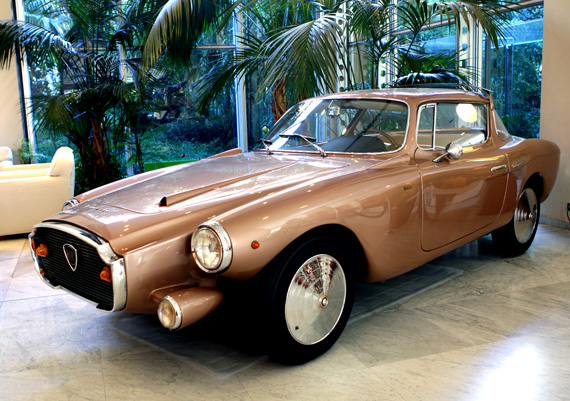
Lingotto's Lancia Loraymo in the lobby
Story and color photos by Jonathan Sharp
You may not be that familiar with Lingotto but if you have seen the original (and by far the best version) of The Italian Job , you may recall the scene in the film where the three Mini Coopers containing the stolen gold are pursued by the Police in their Alfas around a banked test track. That test track is on the roof of Lingotto, the Fiat factory which is located in a suburb of Turin.
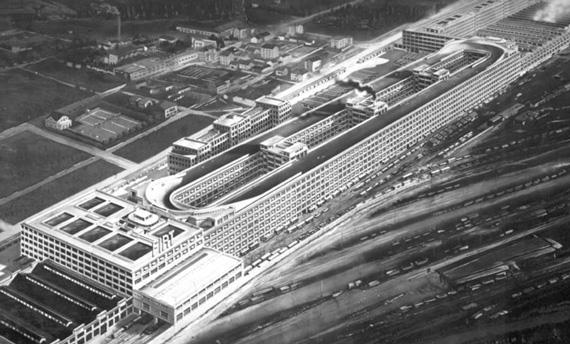
Lingotto Fiat factory as it appeared in 1928. Photo Wiki Commons.
The movie was again shown on the U.K. Channel 4 TV as part of their Christmas television schedule this year. It has become a bit of a tradition over the years for them to do so, and reminded me that the once state-of-the-art Fiat factory, is now – among other things – an upmarket hotel. I always wanted to stay there and the opportunity arose in early December when my wife and I decided to spend a weekend in Italy to stock up on Italian Christmas goodies, enjoy the artistic Christmas lights, and for us to visit the nearby Museo dell’Automobile.
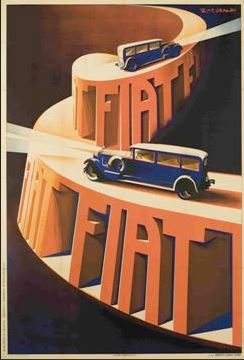
Factory posters of the twenties reflected the Lingotto productoon line.
Even before WWI Fiat was expanding automobile production; the advent of the war accelerated the process as Fiat was also making trucks, marine engines, tanks, and aircraft. Profits were put back into the business and the factory was constructed in as one wag put it, “a field of flowers belonging to Agnelli.” Construction was completed by 1922. Like Ford’s Rouge River Rouge plant, the new factory was self-contained, truly state of the art, and spearheaded an astonishing spurt in production.
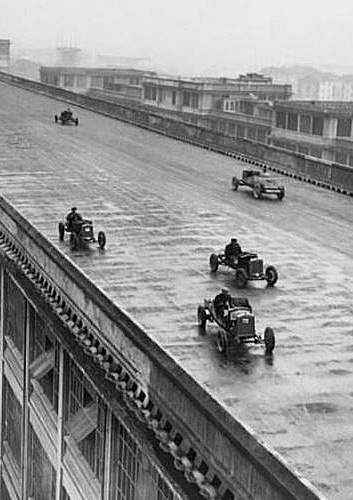
No race, but Fiat chassis being tested on the track on the roof.
The Lingotto factory was the first example of modular construction using reinforced concrete and it is constructed in the form of two parallel buildings, each 507 meters (1662 ft) in length, 5 stories high and each arm is joined in three places by 5 story high office linkways. At each end of the building there was a spiral ramp linking each floor. The building itself had an internal volume of approximately one million cubic meters.
Raw material entered into the building at ground floor level, and the finished product was then driven onto the roof top track for testing. The products were then driven off the building via the spiral ramp directly to the adjourning railway yards to be distributed worldwide. It is these railway lines and also the close proximity to the river Po on the opposite side of the factory that dictated that the production line be spiraled upwards rather than laid out horizontally as was the case in the Ford factories in Detroit.
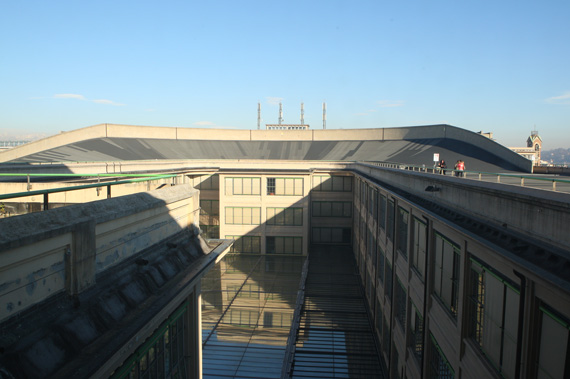
Banking is still in place on the roof and made famous by 'The Italian Job.'
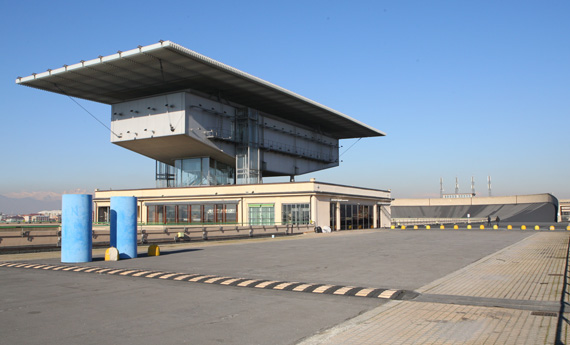
Pinacoteca Giovanni e Marella Agnelli Art Gallery.
The building now contains an exhibition hall (Lingottoe Fiere), an auditorium, two hotels, a large shopping and restaurant gallery, and the Engineering faculty of the Turin Polytechnic. The Pinacoteca Giovanni e Marella Agnelli Art Gallery is located on the roof together with a restaurant and “The Bubble” which, to my mind, is probably the most striking exterior feature of the makeover. It is a glass dome meeting room for up to 25 persons with an attached helipad and is located, like the Art Gallery and an upmarket restaurant on the roof of one of the connecting buildings situated between each arm of the factory. Whilst the interior of the building has completely changed, the exterior and connecting ramps at each end remain as they were during the factory’a glory days. Indeed, to get between the various floors of the shopping gallery one can still walk up and down the spiral ramps, which is so much nicer than using an escalator. The office building in front of the river facing side of the factory which was built in 1928 still contains the Head offices of the Fiat group.

The glass dome and heliport.
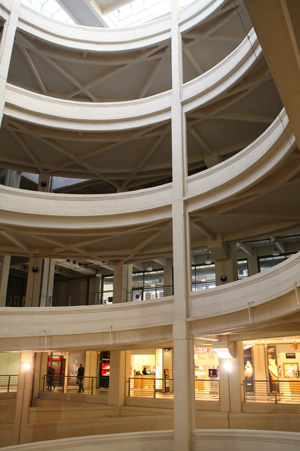
The spiral ramp at the City end of the building which now forms part of the Super 8 shopping center, make sure you bring your credit card if you enter into here.
The Hotel interior is very modern and spacious, making full use of the original height of each floor of the building. I had to wonder which part of the construction of the motor cars took place it what was now our very large and comfortable room.
*If you are wondering about the Mirafiori plant, it is located west of Lingotto and began to produce cars after WWII as within ten years the Lingotto factory was out of date, though still active. The 2 million sq. meter Mirafiori factory produced the bulk of the cars in th 1960s and 1970s, but later on Fiat began to relocate assembly to southern Italy and abroad. Today only the Alfa Mito is produced at Mirafiori. Click here for the Lingotto Hotel.
Next week: Visiting The Museo dell’ Automobile
Reader Interactions
January 21, 2014 at 2:24 pm
The building looks beautiful but that car is quite possibly the most hideous thing on four wheels that I‘ve seen in my life; and I’m 64 years old.
January 21, 2014 at 2:49 pm
There is (was) a book on the Autosalones in Torino: http://www.amazon.it/dellAutomobile-Valentino-Lingotto-Presentazione-Giovanni/dp/B008F8RO4Y/ref=sr_1_13?s=books&ie=UTF8&qid=1390332697&sr=1-13&keywords=Lingotto The second part (approx.) 60 pages, deals with Lingotto with interesting photos.. And it shows the models for the architectural contest for further development of Lingotto, which Renzo Piano finally won..
Best regards Michael
January 21, 2014 at 8:56 pm
Ron; I have to disagree. While the long nose looks awkward, the shape can grow on you, and given that Loewy was nothing if not a showman, and this was the tail end of the fifties, it is no better or worse than many other one-offs of the time. Yes, he did say that parts of the design may have influenced the Studebaker Avanti which today is recognised as one of the best looking of any sports coupe made in America, and yes, it is certainly nothing like the classic Lancias by PininFarina, Bertone or Zagato, but as a styling exercise I think it quite successful. It is just a shame there are not more such daringly different designs to choose from today. Google some more images and have another look Ron, you might get to like it.
January 21, 2014 at 11:35 pm
Being a Fiat tragic, I had the pleasure of staying at the beautiful NH Lingotto Hotel in July last year, staying there for 3 nights. My friends and I thoroughly enjoyed the experience, which was capped off with a walk around the roof.
January 22, 2014 at 12:28 am
I have to go with Ron here. Chris also has a point and other photos of the car show it to be quite pretty but only up to the headlights!! The factory on the other hand is very neat. Google maps has great views overhead as well as street views. Check it out. Thanks Pete for bringing us these wonderful articles.
January 22, 2014 at 1:00 am
Dear Peter Vack, An inquiry as to whether you would allow the article, “A Visit to Fiat’s Remarkable Lingotto”, to be sent to FIAT Club of NSW, Australia, members? At a recent meeting three club members showed a power point of their visit to Lingotto. This text and photos would therefore be of great additional interest. Of course I would make sure VeloceToday and you were credited with authorship and original publishing. P.S. I own an A, B and C model Topolino. For your consideration, Regards,
January 22, 2014 at 5:14 am
Ron, I’m with you mate – it’s a stinker. And yet… It at least has some character, something which has essentially been lost on today’s bloated ciphers. Cars seem to have gone the way of the biccyle, all being tiny variations on a unversal theme. And what happened to charm, or (whisper it) beauty? Why the unending queue of aggressive, assertive horrors? Maybe that’s why I drive a Lancia Fulvia as my daily driver, which is of course directly related to the Laraymo in time and lineage; which is where we came in… Best wishes Will
January 25, 2014 at 10:41 pm
When a few minor things were being done to my Flaminia Zagato at the Lancia works, I noticed a shape nearby under a dusty tarp. The men pulled it back and there was the Loraymo, which I’d seen in a magazine article a year or so previous. “Would you like to buy this?” one asked. I said no, it wasn’t very nice looking, and they glumly agreed and covered it back up. I sure think it was silver-gray at that time, though I could be wrong: there was more dust under the cover than on it!
The Fiat factory in Turin that has a test track on the roof
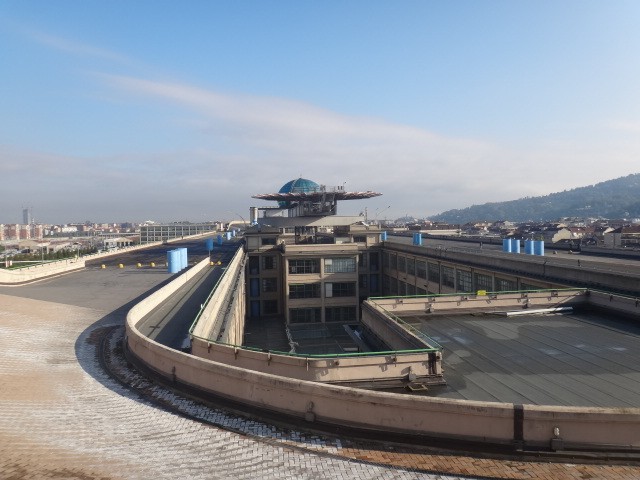
Turin is a beautiful Italian city with famous landmarks like the Palazzo Reale and the Mole Antonelliana, but if you’re looking for unusual or alternative things to do in Turin , try the Fiat Lingotto Factory . This car factory has now closed down but it was where they made Fiat cars from 1923-1982. The Lingotto building has since been renovated and turned into a commercial complex with hotels and a shopping mall , and you can visit it and see its most unique feature – a race track on the roof!
The Fiat Lingotto Factory was built in 1916 by architect Giacomo Mattè-Trucco , and was designed in a very special way that allowed every step of the car-making process to be carried out there. It was close to the train tracks so that raw materials could be delivered straight to the door and manufacturing work on the Fiats would start on the lower floors. The factory has a winding, internal ramp so that the cars could be driven up successive floors as they moved along the various stages of production. Finally, the finished cars would be taken to the top floor – the roof of the building where there is a test track for the cars to be road tested before they were taken to the showrooms to be sold.
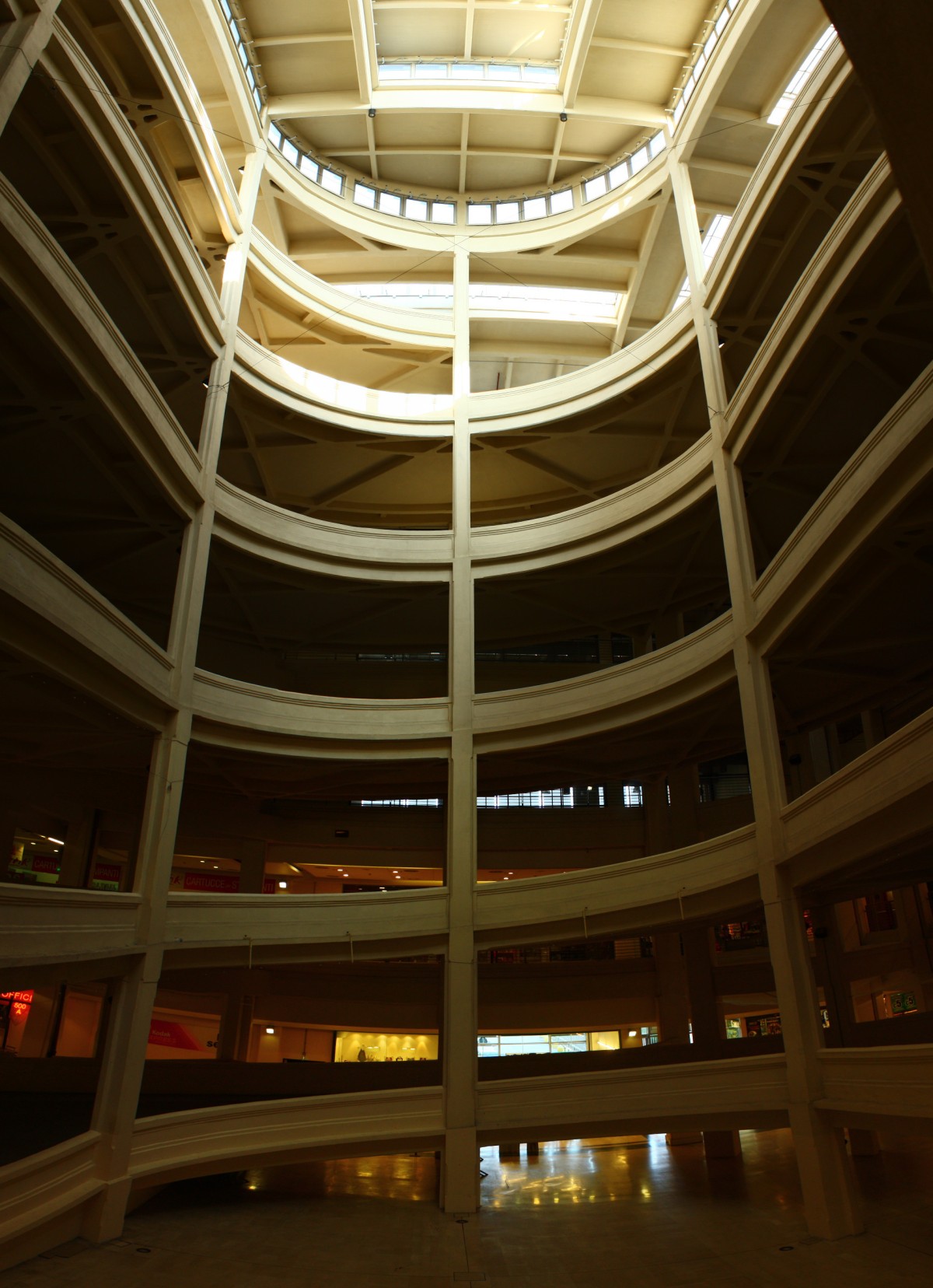
You may recognise this distinctive Fiat test track on top of the building from a scene in the 1969 film ‘The Italian Job’ with Michael Caine, which was filmed in Turin . One of the shooting locations for the chase scene with the Minis near the end was the Turin Fiat factory.
How to get to the Fiat factory rooftop
Unfortunately, you can’t drive around the test track but you can go up and visit it. Head to the enormous Lingotto building right next to the Lingotto metro station .
You will have to take a lift inside the Pinacoteca Agnelli art museum to get up to the roof, for which the entrance fee is around 8 euro . Once you get up there, the view of the city of Turin is fantastic and the test track itself is an impressive feat of architectural engineering.
There is no tour or anything that really commemorates the halcyon days of the Fiat factory circa 1929, but if you want to find out more about Turin’s car manufacturing industry you can go to the nearby Automobile Museum, the Museo Nazionale dell'Automobile , which is one of the best museums to visit in Italy .
- Where: Via Nizza, 262, 10126 Turin, Italy
- Opening hours: Tuesdays to Sundays, 10:00 – 19:00; closed on Mondays
- Price: 8 euro
Find property on idealista
- Find property for sale in Turin, Italy
- Find long-term rentals in Turin, Italy

UNESCO World Heritage sites in Italy: 4 cities not to be missed
Italy, renowned for its rich history, vibrant culture, and stunning landscapes, is home to more UNESCO World Heritage Sites than any other country in the world. From ancient Roman ruins to Renaissance masterpieces and awe-inspiring natural landscapes, these sites embody the essence of Italy's cultural and historical significance. Each location offers a glimpse into the nation’s past, showcasing centuries of art, architecture, and innovation. In this article, we will take you on a journey throu

Rome looks at plans to charge tourists at the Trevi Fountain
The Trevi Fountain in Rome may soon introduce an entry fee. The idea was initially suggested by the Councillor for Sport, Tourism, Fashion, and Major Events, Alessandro Onorato, and later confirmed by Mayor Roberto Gualtieri. Access to the most famous of Rome’s fountains, commissioned by Pope Clement XII, may become controlled and time-limited, with a booking system: free for Romans and with a symbolic charge of one euro for tourists.

Italy's Costa Smeralda: where does the "Emerald Coast" get its name?
Italy's Costa Smeralda (Emerald Coast) is one of the most beloved and appreciated tourist destinations in Sardinia and all of Italy. The reason is simple: here, you’ll find some of the most beautiful beaches in Europe and the sea is crystal clear. Moreover, in the various towns along the coast, there are plenty of things to do and see, with numerous events and festivals organised every day. But have you ever wondered where the name "Emerald Coast" came from? We'll give you a clue - it has noth

Palermo among the best destinations in the world for remote working
Dubai, in the United Arab Emirates, remains in first place for the second consecutive year in Savills' Executive Nomad Index report, which ranks the top 25 destinations for remote workers, known as "digital nomads". The destinations on the list offer pleasant climates year-round, high quality of life, and well-structured residential property markets, along with various benefits, such as specific programmes for those who need to reside abroad for extended periods. Some European countries and the

The 10 most beautiful beaches in Sicily
Sicily is a land of a thousand facets, a 360-degree tourist destination, perfect for lovers of culture, art, and the sea. There are numerous places to visit, each offering new and interesting aspects to discover. For those who love the sea, there’s plenty of choice: wherever you find yourself on the island, there will always be a wonderful beach where you can spend a day relaxing beside the water. Here are the 10 most beautiful beaches in Sicily, from wild and untouched gems to those equipped

Where to go on holiday in Sicily: 24 destinations to visit throughout the year
Sicily, with its rich historical and cultural heritage, stunning beaches, and breathtaking landscapes, offers a wide variety of experiences for every type of holiday. If you're looking for a city break to explore the main cultural attractions, you might visit Palermo or Catania; if you're interested in charming villages, consider Eastern Sicily; if you're seeking the sea, there are numerous islands, the Trapani coast, and more. So, here’s where to go on holiday in Sicily.

The best food in Southern Italy: discover the local cuisine
This guide will introduce you to the best food Southern Italy has to offer, from the bustling streets of Naples to the picturesque coastline of Amalfi. This is our guide to the best food in Southern Italy.
Turin's former Fiat factory, one of Italy's most praised examples of early-20th-century industrial architecture, is 5km south of the city centre. It was redesigned by architect Renzo Piano in the 1980s to house an exhibition centre, a university campus and hotels. The starkly beautiful space today houses the 8 Gallery shopping mall, the Pinacoteca Giovanni e Marella Agnelli and a former rooftop car test track.
Lingotto is on the M1 metro line and easily accessible from the city centre.
Via Nizza 294
Lonely Planet's must-see attractions

Museo Egizio
Opened in 1824 and housed in the austere Palazzo dell'Accademia delle Scienze, this Turin institution houses the most important collection of Egyptian…

Castello di Rivoli
Some 21km west of Turin, the Castello di Rivoli Museum of Contemporary Art is a giant of modern art in Piedmont. Its ambition and reach, not to mention…
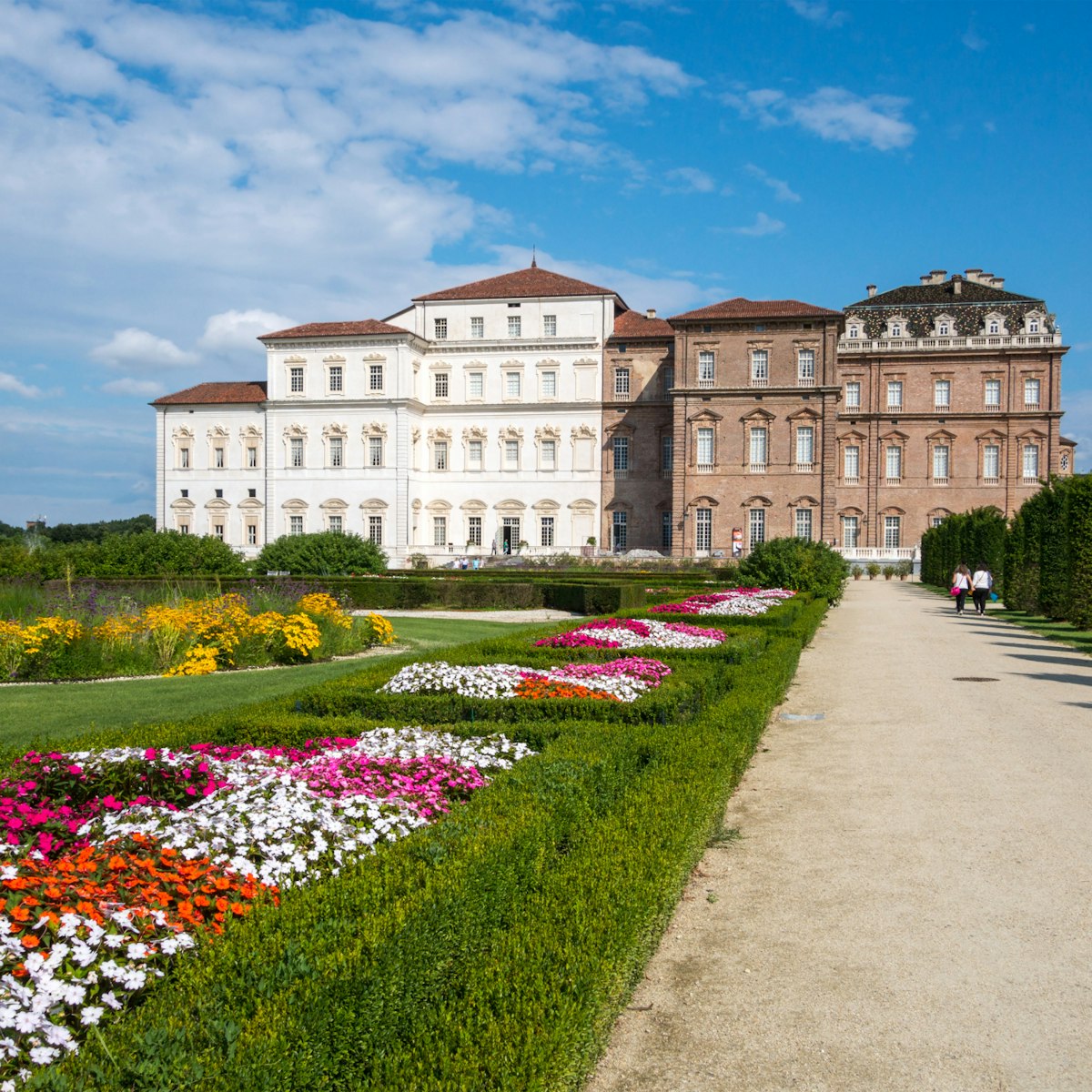
Reggia di Venaria Reale
OK, it may not enjoy the weighty publicity of its French counterpart, but this is one of the largest royal residences in the world, rescued from ruin by a…

Sacra di San Michele
16.45 MILES
This Gothic-Romanesque abbey, brooding above the road 14km from Turin, has kept sentry atop Monte Pirchiriano (962m) since the 10th century. It housed a…

Museo Nazionale dell'Automobile
As the historic birthplace of one of the world's leading car manufacturers – the ‘T’ in Fiat stands for Torino – Turin is the obvious place for a car…

Palazzo Reale
Statues of the mythical twins Castor and Pollux guard the entrance to this eye-catching palace and, according to local hearsay, also watch over the…

Museo Casa Mollino
Architect-designer-artist Carlo Mollino is perhaps Turin's most intriguing son and a quintessentially 20th-century Torinese. The little-known Museo Casa…

Basilica di Superga
Vittorio Amedeo II's 1706 promise, to build a basilica to honour the Virgin Mary if Turin was saved from besieging French and Spanish armies, resulted in…
Nearby Turin attractions
1 . Pinacoteca Giovanni e Marella Agnelli
On the rooftop of the Lingotto building, 3km south of the centre, this intimate gallery houses the personal collection of late Fiat head Gianni Agnelli,…
2 . Museo Nazionale dell'Automobile
3 . Borgo Medievale
Perched over a scenic stretch of the Po River, the Borgo Medievale is a small recreated 15th-century village that was actually built for the 1884 Turin…
4 . Fondazione Sandretto re Rebaudengo
This classic white-cube contemporary gallery space was created with Italian super curator Francesco Bonami and runs a great exhibition program showcasing…
5 . Parco Valentino
Opened in 1856, this 550,000-sq-metre French-style park kisses the banks of the Po and is filled with joggers, promenaders and lovers night and day…
6 . Galleria Civica d'Arte Moderna e Contemporanea
GAM was one of Italy's first modern-art museums and has an astounding 45,000 works in its vaults dedicated to 19th- and 20th-century European artists,…
7 . Fondazione Merz
The Arte Povera powerhouse, Mario Merz, was born in Milan but spent most of his creative life in Turin. This foundation space, an evocative reworking of…
8 . Chiesa di Santa Cristina
This ornate marble- and granite-fronted church is one of the pair of churches on Piazza San Carlo and dates to 1639.
Lingotto district tour

Other from Turismo Torino e Provincia
- Work with us
- Privacy Policy
- Images of the day(s)
- Video of the day(s)
- Coronavirus
- Insert your Classified
- How to insert your Classifieds
- Insert your Yellow Page
- About our Yellow Pages
- Where to live in Milan
- Advertise with Us
Wanted in Milan Membership
Latest news
- Yellow Pages
- Classifieds
- Images of the day
- Video of the day
- Coronavirus in Italy
Urban areas
- Bicocca district
- Corso Como area
- Navigli area
- Montenapoleone and Duomo areas
- Porta Magenta area
- Porta Romana neighborhood
- Porta Venezia, Corso Buenos Aires
- EU’s General Data Protection Regulation (GDPR)
- Entertainment
- Discover Milan
- Jobs vacant

Fiat Lingotto Factory: From Automotive Icon to Cultural Venue
Turin’s historic fiat lingotto factory: a legacy of innovation and design.
Turin’s historic Fiat Lingotto Factory, a landmark within the automotive industry and among car enthusiasts worldwide, is most recognized for its five-story test track that coils up to its scenic rooftop speedway.
Although the building is often marked for its enormity and architectural prowess, its true significance is grounded in what it represents – a merging of Italy’s industrial advancements, innovative technology, and cultural legacy.
In 1923, the Lingotto Factory opened its doors as the largest car factory in the world. The immense 16,000,000 square foot space employed over 12,000 workers and cultivated over 80 different models of Fiat automobiles , including the 1936 Fiat Topolino, putting Italy at the forefront of the automotive industry. To this day, the factory symbolizes a paramount period marked by economic growth and modernization, showcasing Italian craftsmanship and timeless design.
Although the factory closed in the 1980s , it set a new global standard and remains a proud reminder of Italy's automotive history, serving as a source of inspiration for modern visionaries.
The Architect and the Factory
The engineer Giacomo Mattè Trucco fulfilled his promise of structural integrity and avant-garde design with the Lingotto Factory by utilizing raw materials, resulting in an industrial masterpiece.
The uniqueness of the building begins at the foundation, as Trucco grounded it with raw materials and built his way up five floors of spiraling steel and concrete. At first glance, its design echoes a similar image to that of the impossible staircase; however, it is nothing less than a fully functional driving course.
Architects in Milan
Historically, cars were assembled along the track that ascended to the rooftop , where they were tested on the 1.5 Km test track capable of handling speeds up to 90 Km/h. The placement of the track above the building was the first of its kind and set Fiat’s Lingotto apart from any other automobile facility.
This ambitious method of production not only contributed to the efficiency of manufacturing but highlighted Fiat’s commitments to quality engineering and assurance. Both appealing and practical, Trucco reinforced the Italian brand’s values while leaving an impressive legacy for himself, continuing to inspire architects and urban planners.
Lingotto Today: A City Within a City
While vintage imagery portrays the architectural oddity as a man-made cement spectacle of the past, the factory has evolved into what some describe as a ‘cultural venue’. After the factory’s initial closure, public discourse broke out over how to revive the enormous Italian landmark in a contemporary way , and the answer has been ongoing. The primary focus was to create a lively city within an existing one by opening up the space to the public in various ways.
Top must see Museums in Turin
This began with the establishment of a shopping mall, exhibition spaces, hotels, offices, learning spaces, and even a tropical garden. However, this upcycling project continues to blossom and expand with more options such as the FIAT CAFÉ 500 . Whether you’re interested in learning more about the history behind Lingotto and Fiat or seeing famous works from Picasso and other influential artists, the factory offers a complexity of culture within an Italian marvel.
Newest Public Attraction
As of 2022, the public has been invited to see the Pista 500: an outdoor art exhibition built into the former test track on the top floor of the Lingotto Factory, curated by the Pinacoteca Agnelli gallery .
The track not only features 40,000 plants and over 300 different species, emphasizing Fiat’s focus on environmentalism and sustainability, but the space is filled with a multitude of different art mediums and viewer experiences. It serves a dual purpose as both a hanging garden and a test-drive track dedicated to Fiat’s new 500e vehicle.
The unique fusion of nature, art, and automobiles has gone a step further in turning the industrial factory into an art project that reinvigorates the building as a hub for Italian creativity and forward-thinking. You can find
General Info
View on map.
Lingotto, Torino, TO, Italia

Three young Chinese nationals die in Milan store fire
Shock in Italy as teen confesses to killing his family
Mystery customer buys €10,000 worth of books in Milan bookshop
Milan's Malpensa airport floods as northern Italy hit by heavy rain
Italy launches summer tourist train from Milan to Tuscany's coast
Latest Whats'on
Smiling International School of Ferrara to host the Houston Space Center
Live shows in Milan not to miss this February
Tim Burton’s exhibition in Turin
Taylor Swift to perform two sold-out concerts in Milan on 13-14 July
English artists on Lake Como
Latest Classifieds
Romantic Loft between Navigli and SDA Bocconi
Classic and elegant apartment for sale near Piazzale Flaminio
Searching job as cleaning and ironing
The British Consulate in Milan is seeking a Consular Officer
ENGLISH PERSONAL TRAINER MILAN
Latest Yellow Pages
Smiling International School in Ferrara
Doctors in Italy
The Italian School of Milan
ICS International School in Milan
International School of Monza
EVENTS THIS WEEK
Stay connected.

The Wanted Network

Wanted in Rome

Wanted in Europe

Wanted in Africa
Milan areas
Latest what's on.

Latest classifieds
- Accommodation vacant in town

- Property for sale in town

- Jobs wanted

More like this Related
Turin clamps down on smoking outdoors

Johnny Depp starts filming Modigliani biopic in Italy

Ronaldo and Juventus out at the Champions League’s round of 16
Italy: Motorist drove 6 km in wrong direction on Turin bypass
Italy: Turin chefs help to feed people hit by covid-19 crisis
Turin: €1,000 fine for driving electric scooter at 100 km per hour
Public transport in Turin goes contactless
Wanted in Milan TM
- Environment
Wanted in Milan ™ is member of the Wanted World Wide Ltd network. Click here to find out more about our Network or Follow us on social networks.
Wanted in Milan
- Accommodation wanted
© 2024 / 2025 Wanted World Wide LTD Network. All Rights Reserved. Made with Kraken PMS.

The original Fiat factory in Lingotto, Turin
Automotive past grandeur.
The Fiat car company and its founders the Agnelli family are the perfect medium to understand the development of Italian politics, industry and design in the 20th Century.
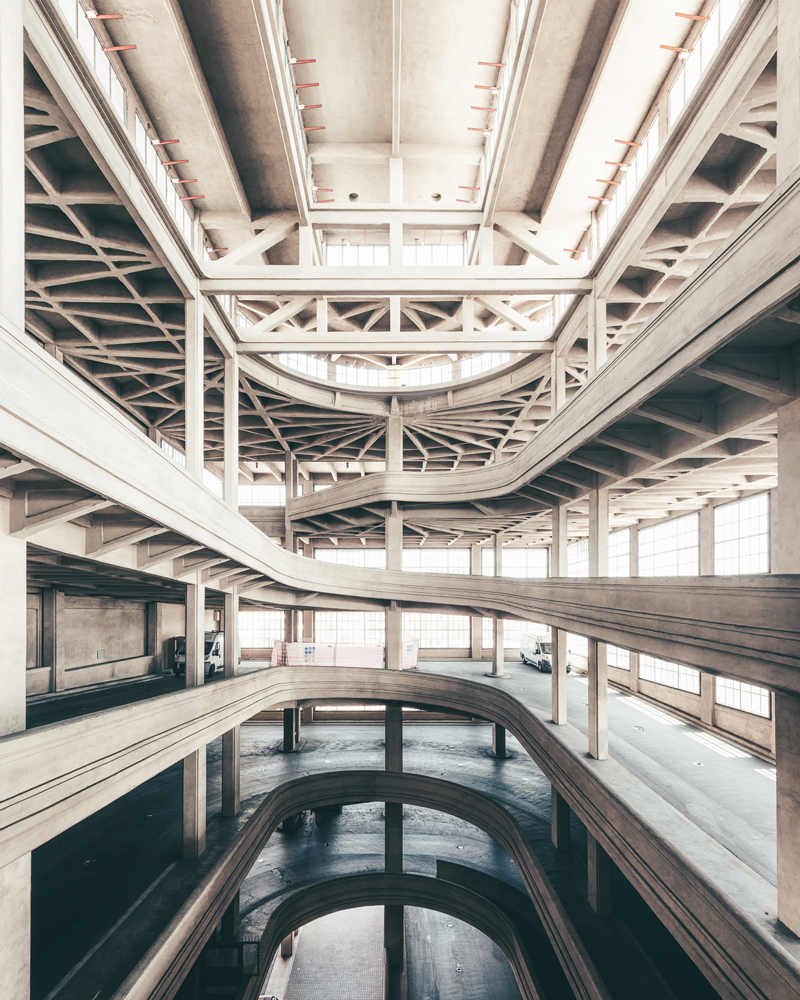
Giovanni Agnelli sat in the driving seat, so to speak, in the rapidly developing car industry. He’d been to Ford in Detroit and was very clear about what he wanted to introduce to Italy. He understood the importance of reaching a mass market and the necessity to find a way to ramp up production. He had several interim factories before Lingotto, which would become Europes’ largest car production facility at one point. The huge new factory designed by Giacomo Mattè-Trucco dominated the Lingotto district of Turin. 500m long, five storeys high and with a test track on the roof (immortalized in the film The Italian Job).
Fiat is an acronym for Fabbrica Italiana di Automobili Torino but it’s also a Latin expression, ‘Let it be done.’
The factory was operational from 1923 to 1982 and it’s hard to believe, given the fame of the building, is that there has been no car production on site for more than 30 years. But the Agnellis knew that in its post motor life Lingotto had a real value. Less than 2 years on from the production lines being switched off, new ideas were being considered for the space.
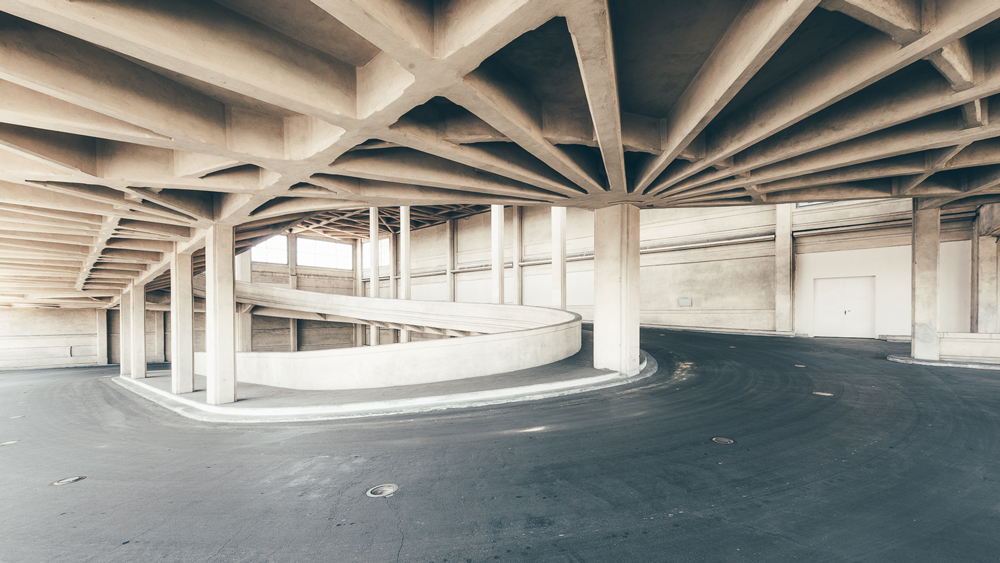
Italian architect Renzo Piano won a 1982 competition to change the exhausted factory into a very different space.
Renzo Piano Building Workshop explains,
‘The building’s exterior remains largely unaltered, but its interior was completely modified in order to accommodate an exhibition centre, a conference centre and auditorium, two hotels, offices and retail space. In 1997, Fiat group’s management headquarters returned to the office block. In 2002, Turin Polytechnic’s automotive engineering department was also installed in the building.’
Today we can get a real sense of the magnificent design of the building from Belgian photographer, Reginald Van de Velde’s photos. He notes that Ligotto is one of the finest ways of experiencing in person ‘automotive past grandeur’ and reminds us that ‘there are only three factories in the world that have a rooftop test track. This is one of them. Bucket list material without doubt’.
More about Reginald Van de Velde
Reginald’s awarding winning photos have been widely exhibited including at the New York Photo Festival, Somerset House in London. He’s been published in National Geographic Magazine, Wired, Esquire and numerous other publications. Awards include the Grand Prix de la Découverte at the Cannes Lions International Festival and in 2020 the Aerial Photography Award.
See more of Reginald’s photos on his website Suspiciousminds
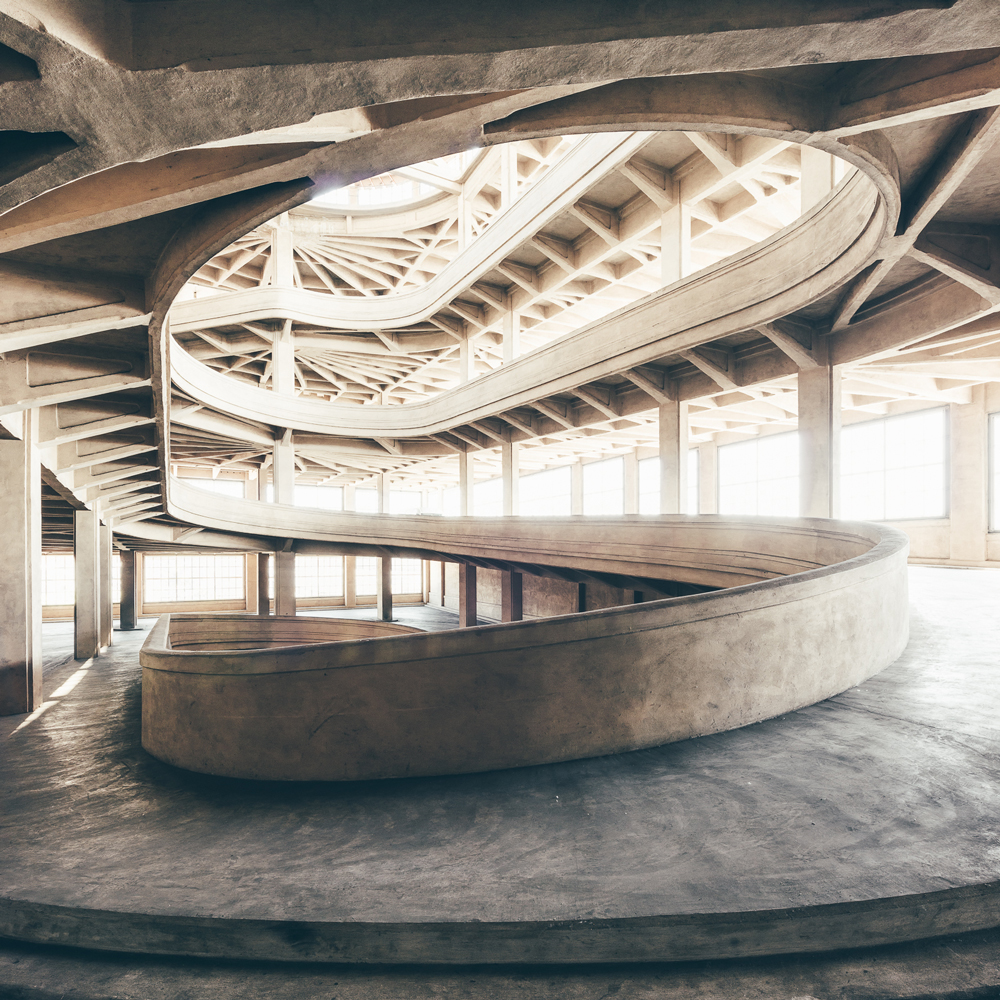
Images Copyright of Reginald Van de Velde ©
Share on social, what people are saying, related products.
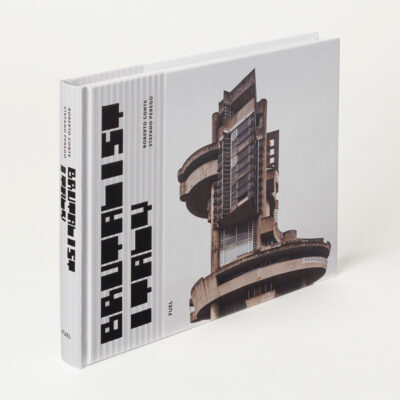
Brutalist Italy, Roberto Conte and Stefano Perego
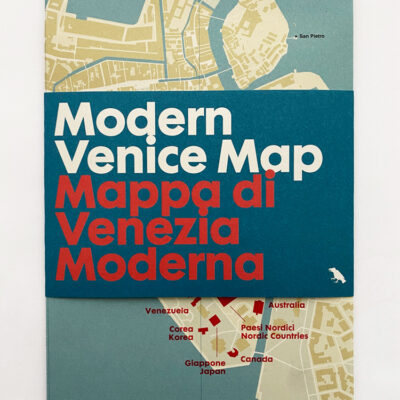
Modern Venice Map | Mappa di Venezia Moderna
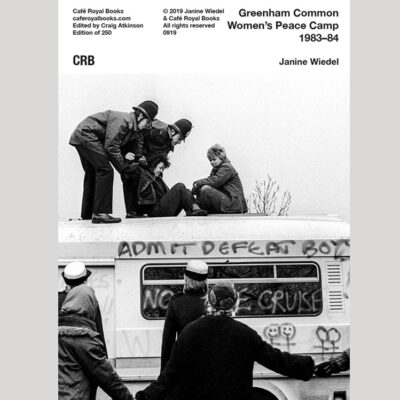

Greenham Common Women’s Peace Camp 1983-84: Janine Wiedel Cafe Royal Books
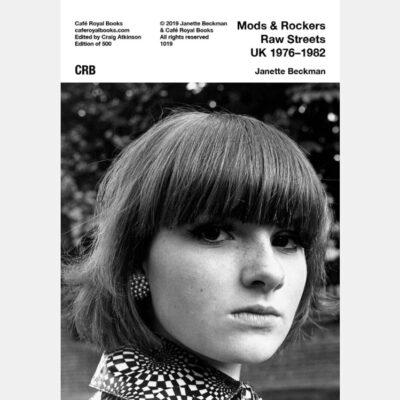
Janette Beckman Mods & Rockers Raw Streets UK 1976–1982
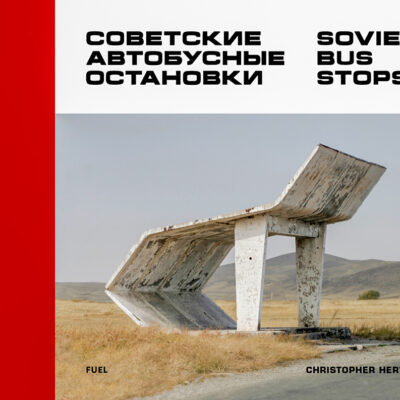
Soviet Bus Stops: Christopher Herwig

Brutalist Calendar 2024

Gropius, An illustrated biography of the creator of the Bauhaus by Reginald Isaacs

Soviet Asia: Soviet Modernist architecture in Central Asia by Fuel
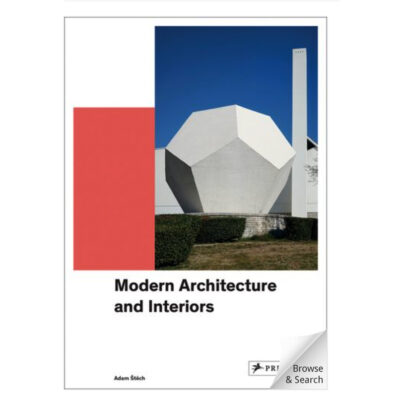
Modern Architecture and Interiors by Adam Štêch
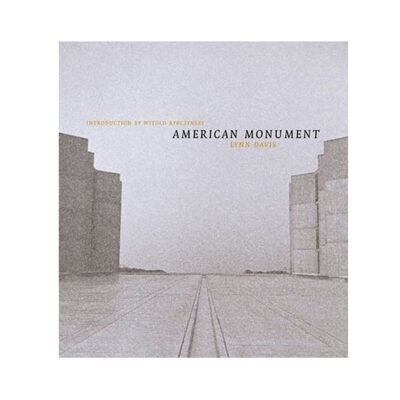
American Monument by Lynn Davis

Hip Hop Years The B Sides 1982-2020 Janette Beckman Cafe Royal Books
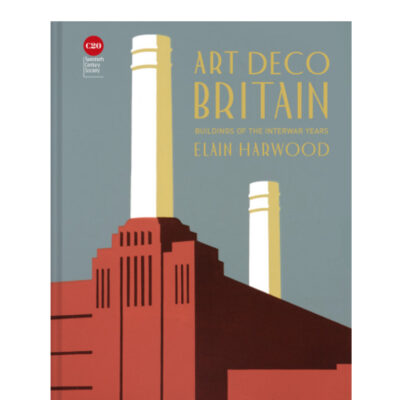
Art Deco Britain, Buildings of the Interwar Years Elain Harwood
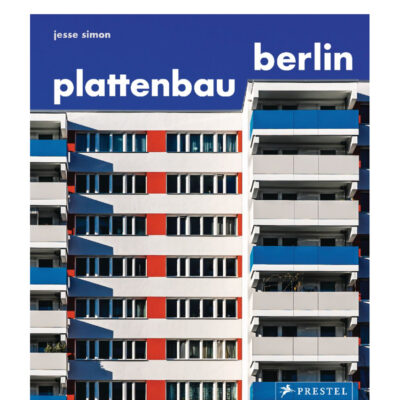
Plattenbau Berlin: A Photographic Survey of Postwar Residential Architecture
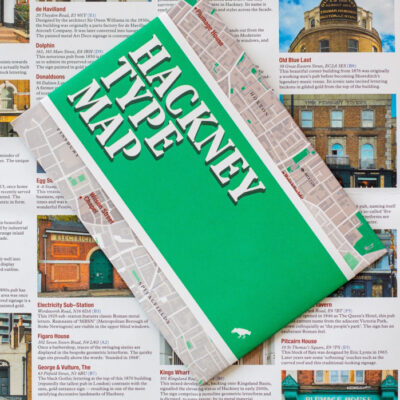
Hackney Type Map
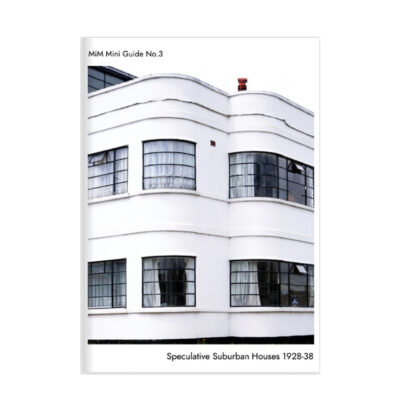
Speculative Suburban Houses 1929-38 Modernism in Metro
Related posts.
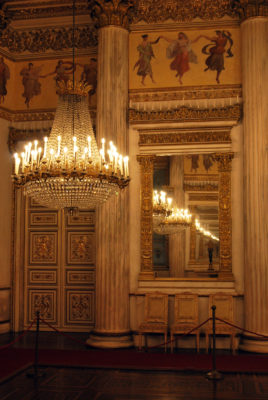
Turin or Torino, both correct, it just depends on who you ask
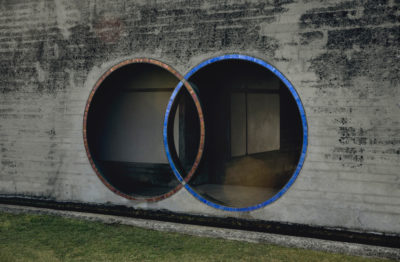
The Tomba Brion Cemetery
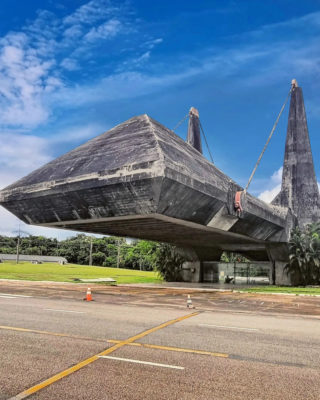
Brazilian architect Lelé’s big bold vision Centro Administrativo de Bahia Salvador Brazil
@barbican_city_of_london.

Subscribe to our mailer
Keep up to date with Greyscape by signing up to our newsletter
Follow us on social #Greyscape + #Barbicancityoflondon
For customer services you can email us at
Terms and Conditions
Privacy Policy
Cookie Policy
Shipping and Returns
© 2024 GreyscapeRegistered trade mark
Site Designed By The Digital Fairy

- How Good is Your Plan?
Login on Weekend in Italy
Username or password is incorrect, welcome back,, industrial turin: agnelli art gallery and automobile museum, step into industrial turin - and discover great art, exciting architecture, and industrial treasures.
- Plan your visit
Guided tour of the Industrial Turin: Agnelli's Art Gallery - located at top of the old Lingotto factory, a symbol of Fiat, within the Scrigno designed by Renzo Piano - which houses works of enormous value of artists such as Canova, Manet, Renoir and Picasso. The tour continues with a coach ride from where you can admire the first FIAT factory, the Olympic Stadium and the annexed architectural works, up to the Automobile Museum, that you will visit inside.
Info & Booking
- Available : from Wednesday to Sunday at 10am. Not available on December 24, 25 and 31st, and on January 1st.
- Duration : 5 hours
- Meeting point : the guide will meet at the entrance of Agnelli's Art Gallery, 15 minutes before the confirmed time.
- Group size : Maximum 25 people per group.
- Languages : English, Italian, Polish and Greek.
Cost does NOT include entrance fees, to be purchased at the spot.
It is recommended to wear comfortable shoes.
Cancellation policy : Once the tour is confirmed, it can be canceled up to 1 week prior to receive a refund of tour cost minus the service fee. Further cancellations and no shows are non refundable.
Your tour begins with a one hour visit to Agnelli's Art Gallery – located at top of the Lingotto factory. Built between 1916 and 1923, the Lingotto was once the world's largest car factory (seat of FIAT), and a revolutionary architectural feat. Following the industrial decline, the Lingotto was transformed into an exciting public space by Renzo Piano. The Scrigno (“jewelry box”), a structure which seems to float atop the building, suspended above the rooftop test track, marks the final step of the 20 year long restructuring process. The Scrigno is home to the Agnelli Museum, which displays an extraordinary collection of 23 artworks dating from the 18th to the 20th century and ranging from the Venice of Canaletto and the Dresden of Bellotto to a group, unique in Italy, of seven masterpieces by Matisse, as well as works by Manet, Renoir and Picasso. In addition, the Scrigno always hosts interesting temporary exhibitions.
Your tour continues with a bus ride (1 hour) during which you'll see the first FIAT factory, the Olympic Stadium and the attached architectural complex.
You'll then arrive at the Automobile Museum, where your visit will continue inside (2 hours). Founded in 1960, it was reopened after a great makeover by the studio of the architect Cino Zucchi. The tour covers the history of the automobile, from its genesis to date, with a look towards the future. The Automobile Museum is home to over 200 cars representing some 80 brands. The museum boasts some of the first Italian cars, a 1914 Rolls Royce Silver Ghost, and racing cars by Ferrari and Alfa Romeo, among many other exciting exhibits tracing the history of industrial development and design Made in Italy design.
Cancellation Policy
Once a confirmation code has been assigned to your reservation, we can refund the cost minus a service fee (reservation fee and online booking fee) for cancellations up to 1 week before the event. Cancellations less than one week before your booked event and no-shows are not refundable.
Prices Detail
Subtotal - price details, total - price details, service added successfully, you might also be interested in:.
Turin - Tours
Magical Turin Tour
Underground turin, guided tour historic turin and egyptian museum, city sightseeing turin 3 lines 48 hours, guided by the museum egyptologist: at home with kha, guided by the museum egyptologist: who wants to be pharaoh, guided by the museum egyptologist: divine powers and magic formulae, master class to become a 'senior torino taster', guided by the museum egyptologist: animals or gods, guided by the museum egyptologist: hieroglyphs - what fun.
Turin - Museums
Turin Royal Card
Turin tours, share this service, weekend in italy.
- Inner Circle
- Affiliation
- Join the Club
- Tour Operators
- Partner Network Opportunities
- Satisfaction Guaranteed
- Privacy and Terms of Sale
- How to Order
- Payment Information
- Shipping Methods
Need assistance?
- Compare your itinerary
- On the genious footsteps
- Find here YOUR BEST independent travel
- There is much more....round the corner
- [email protected]
Store Online
Visit our shop and take home something beautiful, enriched by a unique history, with its roots in respect and love for the work of the artisan. We choose one-of-a-kind products, often hard to find elsewhere, from makers our families know and trust. Directly from Italy to your door.
Keep up-to-date with us via our social media platforms. Follow our latest news and adventures, and share our vision of independent travel - the way to know Italy as the special place it is!
Waf.it and Weekendafirenze.com are registered trademark by Weekend a Firenze Srl - Italian Chamber of Commerce permit n. 0469879 - Corporation Stock € 61.200,00 Copyright © 1995 - 2021 by Weekend a Firenze ® s.r.l. - Via Pistoiese 132, 59100 Prato (ITALY) - Fax +39-0574-401744 - p. IVA 02180560480 - Codice Unico M5UXCR1 - All rights reserved
The Rooftop Racetrack of Fiat’s Lingotto Factory
The Lingotto building in Turin, Italy, is a massive half-kilometer long reinforced concrete structure, five stories tall, that once housed the largest and most modern car manufacturing plant in Europe. Located in the heart of the city, its original owners —Fiat—made clever use of the available real estate by building a high-speed test track on the building’s unusual banked rooftop, where thousands of Fiats underwent testing once they came out at the end of the assembly line.

A Vespa racing event on the roof of Lingotto’s Fiat Factory, organized by Red Bull in 2011. Photo credit: www.motoblog.it
Built between 1916 and 1923, the building was the brainchild of Italian engineer Giacomo Mattè-Trucco, and was one of the first buildings of its size to rely heavily on reinforced concrete. Space constraints imposed by the railway lines nearby and the shape of the terrain, forced Giacomo Mattè-Trucco to develop a building that went vertically up and ended in a simple yet ingenious looped rooftop test track with two banked turns. The track is reached by spiral ramps at either end of the building that thread their way up through floor after floor. These ramps are braced by reinforced concrete ribs that radiate from the columns around the central well like the ribs on the underside of water-lily leaves.
The manufacturing plant’s assembly line itself was unusual, and the test track was an integral part of it. Production started at the ground floor and continued sequentially up through the upper floors. As each floor passed, the cars approached their final shape until they emerged as a finished product at the rooftop where they were ready for testing. While the banked sections are impossibly tight making high-speed testing unfeasible, rumors persist that concepts and racing engines were also tested here, including the one-off 1954 Turbina, with its projected 160mph top speed.
The Lingotto Factory produced 80 different models of car putting out an average of 200 daily from it's opening until the 1970s, when it was eclipsed by the modern Mirafiori plant. The last Lancia Delta rolled out of the factory in 1979. Three years later, the factory was officially closed.
The Lingotto building was eventually converted into a modern complex with concert halls, theatre, a convention center, shopping arcades and a hotel. The rooftop track was retained and can still be visited today on the top floor.

Photo credit: thecharnelhouse.org
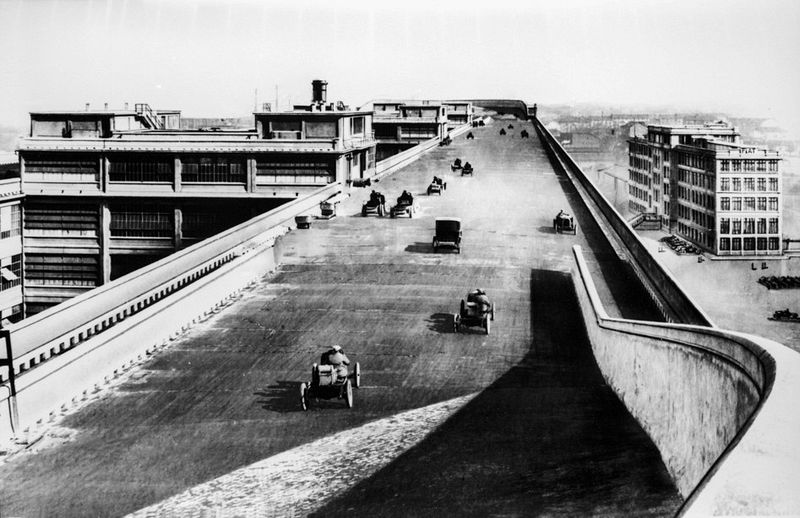
Photo credit: unknown
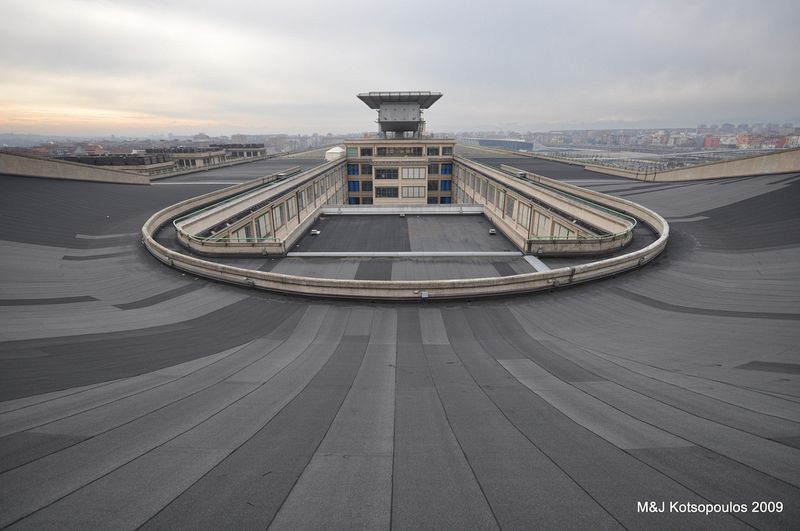
Photo credit: John and Melanie/Flickr

Photo credit: Nicholas Nova/Flickr
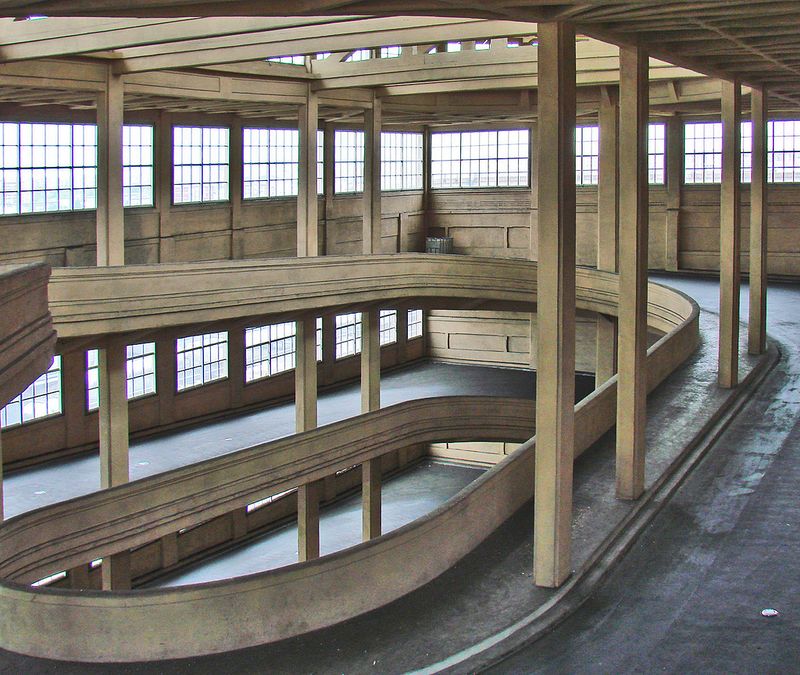
Photo credit: Jean-Pierre Dalbéra/Flickr

Photo credit: Jacqueline Poggi/Flickr
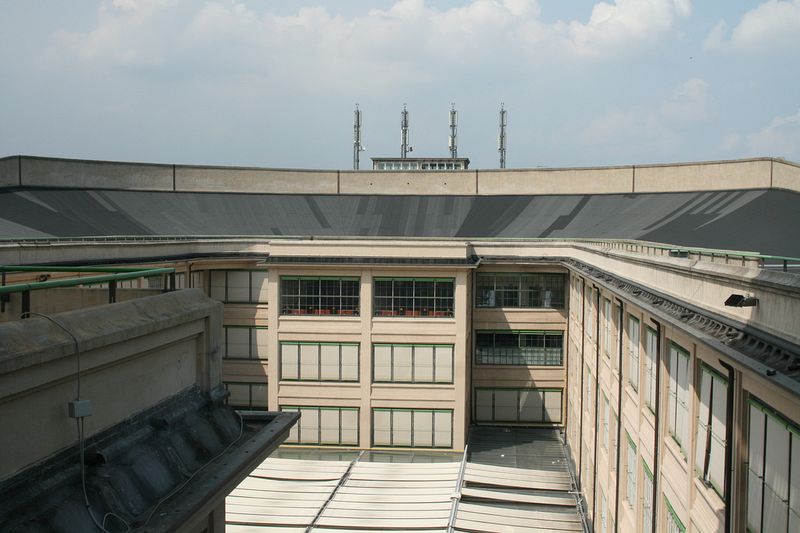
Photo credit: Marcus Winter/Flickr
Sources: Jalopnik / BBC / Wikipedia
Post a Comment
More on amusing planet.
{{posts[0].title}}
{{posts[1].title}}
{{posts[2].title}}
{{posts[3].title}}
Advertisement, featured articles, top countries.
- NURBURGRING WEBCAMS
- WORK FOR US
EDITOR'S PICKS
You Can Drive The Fiat 500 On The Rooftop Of The Lingotto Factory In Turin
Visitors are welcome on the “FIATCafé500” and the La Pista 500 with a special garden located in the iconic test track of Fiat’s Lingotto factory

by Thanos Pappas
Fiat’s Lingotto factory in Italy is known for the rooftop test track which has now been fully renovated with a garden and is open to the public for test drives of the electric 500 . Visitors are also welcome to the “FIATCafé500” inside the Casa 500 museum, where they can learn more about the history of the Italian city car and enjoy their coffee with a special view of Turin.
The Lingotto factory was completed in 1923 as the world’s largest automotive plant at the time. Fiat built a total of 80 models in Lingotto before it was closed in 1982. The rooftop – 28 meters above the city of Turin – is accessible by car through a spiral inside the building. For many years it served as a test track for finished production vehicles and prototypes. In 2020, I was lucky enough to drive a few laps on it, as part of the European presentation of the 500 to the press.
Read Also: The Fiat 500 RED Is A Charming And Easy-Going Urban EV
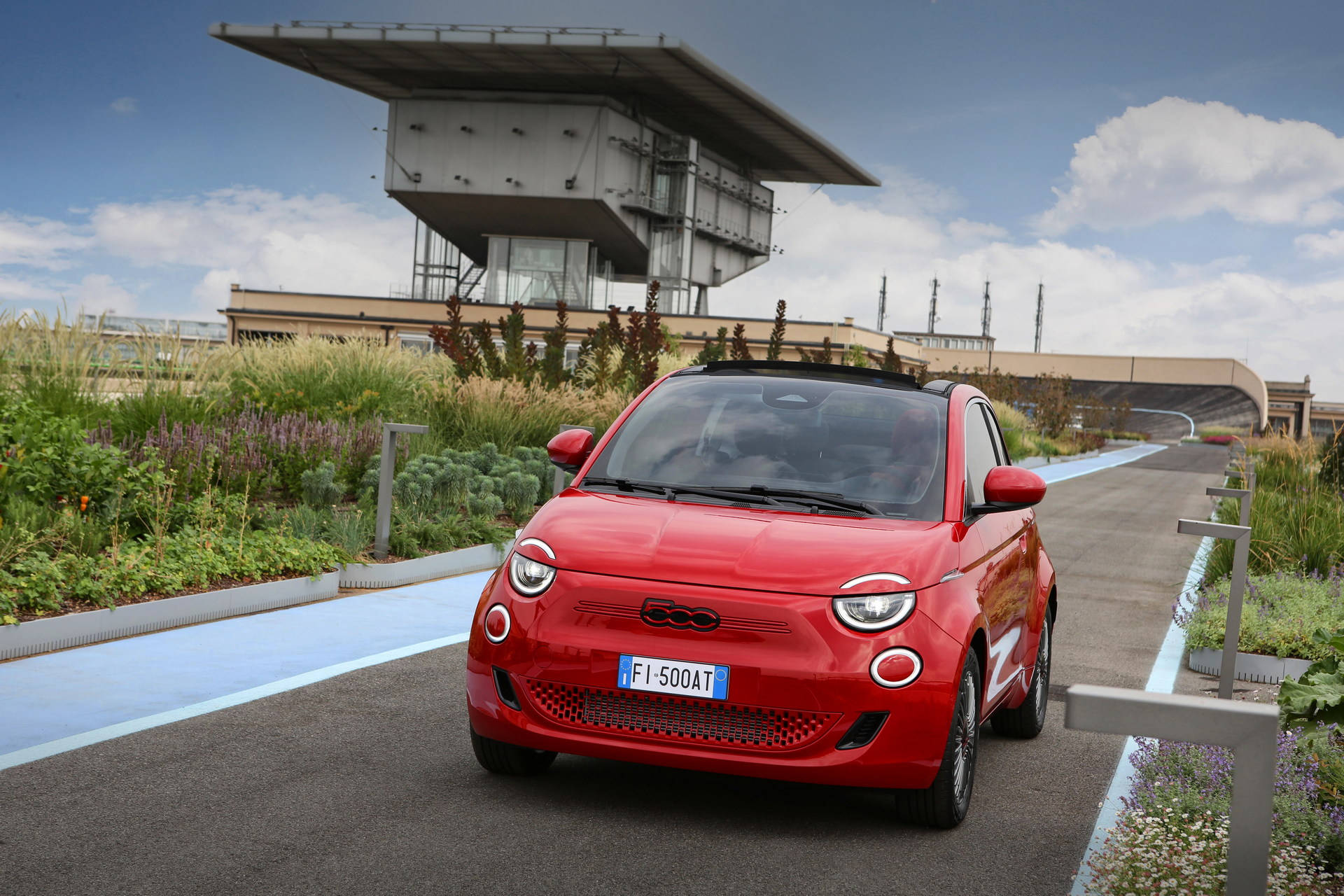
Now, after being redesigned and repurposed into a garden, the rooftop test track has opened again under the “La Pista 500” name. The garden has more than 40,000 plants from 300 different native species, in line with the environmentally-conscious strategy of Stellantis . Thankfully, a portion of the track is retained – including the bends – and visitors are welcome to test drive the electric 500 on Mondays. The rooftop will also host a series of educational activities about electric mobility, called “E-Drive School”.
As for the “FIATCafé500”, it is part of the Casa 500 museum located on the fourth floor of the Pinacoteca Agnelli. There you can enjoy your coffee next to a beautiful wooden model of the original 500, posters, memorabilia and the electric Fiat 500. The cafeteria was designed with an industrial approach, and has a nice view of the “La Pista 500” from the large windows.
A racetrack on the rooftop of Fiat’s Lingotto factory in Italy, 1923
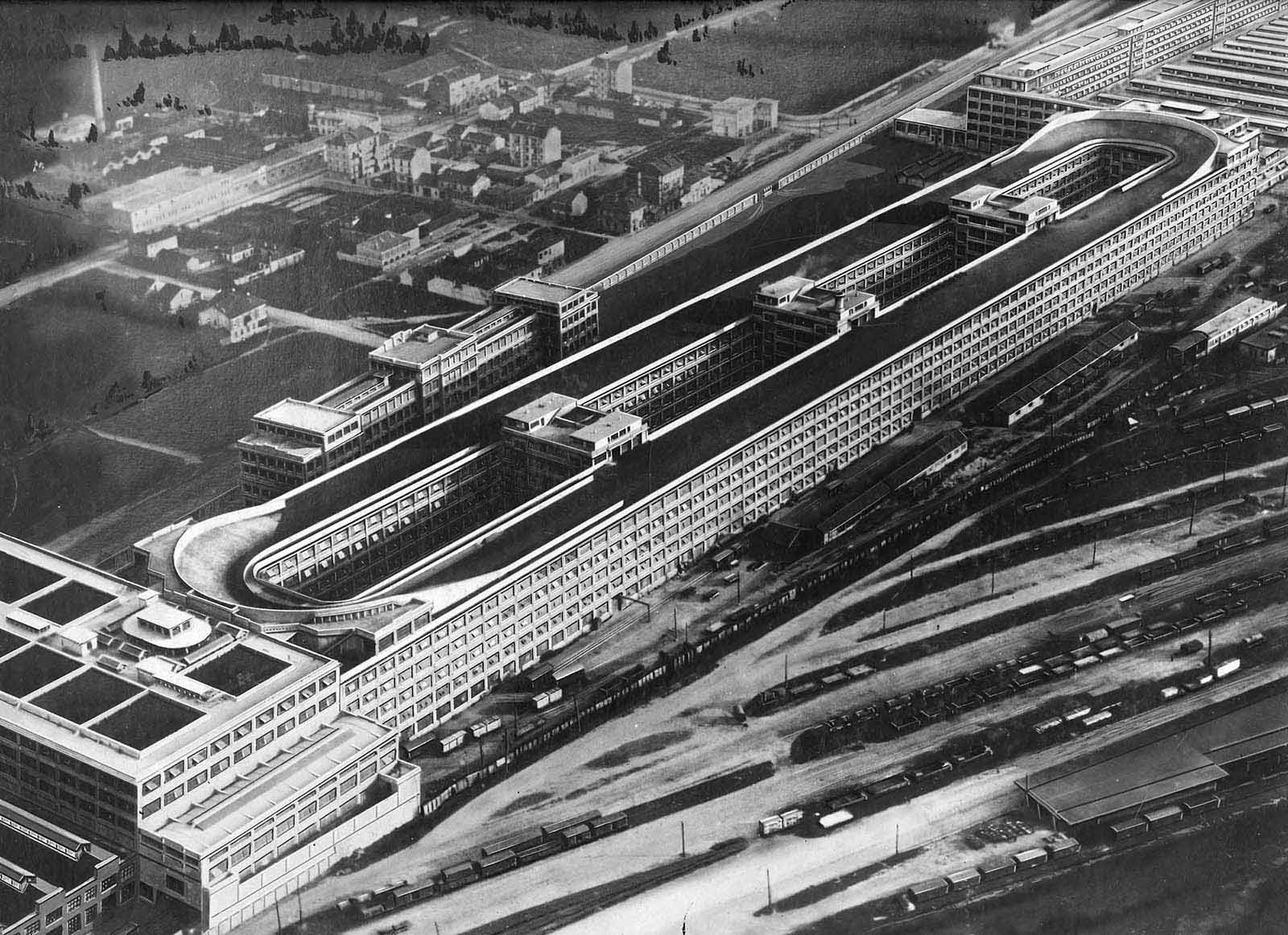
Historical view of Lingotto building with the test track on the roof.
The racetrack on top of a factory is actually a very famous now-defunct Fiat factory located in the city Turin in North Italy. When Giovanni Agnelli, the CEO of Fiat, had visited the Ford factory in Detroit, he then decided to expand production by adopting new and evolutionary production technologies in a state-of-the-art building that was innovative and unique from an architectural point of view.
Built between 1916 and 1923, the Lingotto factory building was the brainchild of Italian engineer Giacomo Mattè-Trucco and was one of the first buildings of its size to rely heavily on reinforced concrete.
The building is formed of two longitudinal bodies, each 507 meters in length by 24 meters wide, joined together by five transversal bodies and two twisted ramps on each end.
The cars were assembled while moving from the ground floor to the fifth floor. Each floor was dedicated to a special construction stage and with assembly lines, allowing workers to not move from their work station, thus reducing assembly times.
The factory’s best-known symbol is the test track, which is a superb piece of design modeling, and construction that occupies the whole roof surface of the workshops. Two 443 meters straights, joined by parabolic bends, form a continuous track for testing the cars.
Originally, as soon as the cars left the assembly lines they could flow directly upward to the test track through the snail-shaped ramps completing the whole processing cycle inside the factory. Moreover, these spiraling ramps inside the building allowed the cars to be driven back down and into showrooms.

Racecars race atop the Lingotto factory.
The Lingotto factory was opened in 1926 in the presence of King Vittorio Emanuele III. At that time, production had already started and the office building was complete. Back in the day, Lingotto was Europe’s most advanced factory with about 12,000 blue-collar workers and 500 white-collar workers working three shifts in a continuous cycle.
For its time, the Lingotto building was avant-garde, influential, and impressive and the famous architect Le Corbusier called it “one of the most impressive sights in industry”, and “a guideline for town planning”.
But what separates Lingotto from American plants of the same period is sheer rhetoric. The American plants are useful and fairly cheap facilities for manufacturing things in.
Fiat, which is uncannily like an American concrete-framed building in all its details, is also a public statement about modem manufacture, about modernity itself. Marinetti hailed it (of course) as “the first invention of Futurist construction.”
By the late 1970s, the factory had become obsolete, and a decision was made to finally close it in 1982. In almost 60 years 80 car models and 35 different types of the engine, as well as commercial vehicles, components, and household appliances, were produced.

Another view of the Lingotto factory in Turin, Italy.
The closure of the plant led to much public debate about its future, and how to recover from industrial decline in general. An architectural competition was held, which was eventually awarded to Renzo Piano, who envisioned an exciting public space for the city.
The old factory was rebuilt into a modern complex, with concert halls, a theatre, a convention center, shopping arcades, and a hotel. The eastern portion of the building is the headquarter of the Automotive Engineering faculty of the Polytechnic University of Turin.
The track was retained, and can still be visited today on the top floor of the shopping mall and hotel. Over time, considerable movie and television production has been filmed at this famously unique location such as the movie The Italian Job, starring Sir Michael Caine.
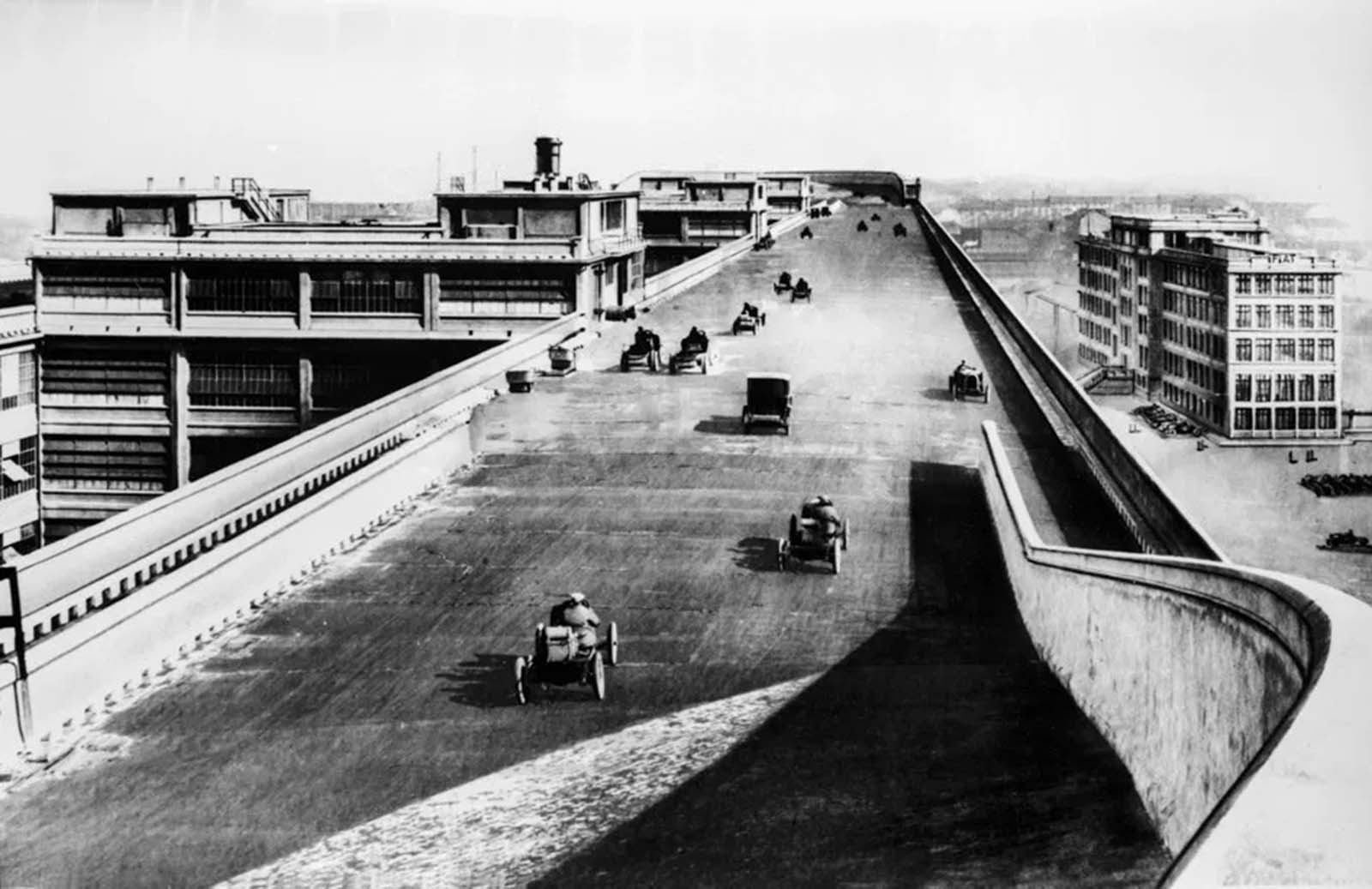
A race taking place in Lingotto’s iconic rooftop racetrack.
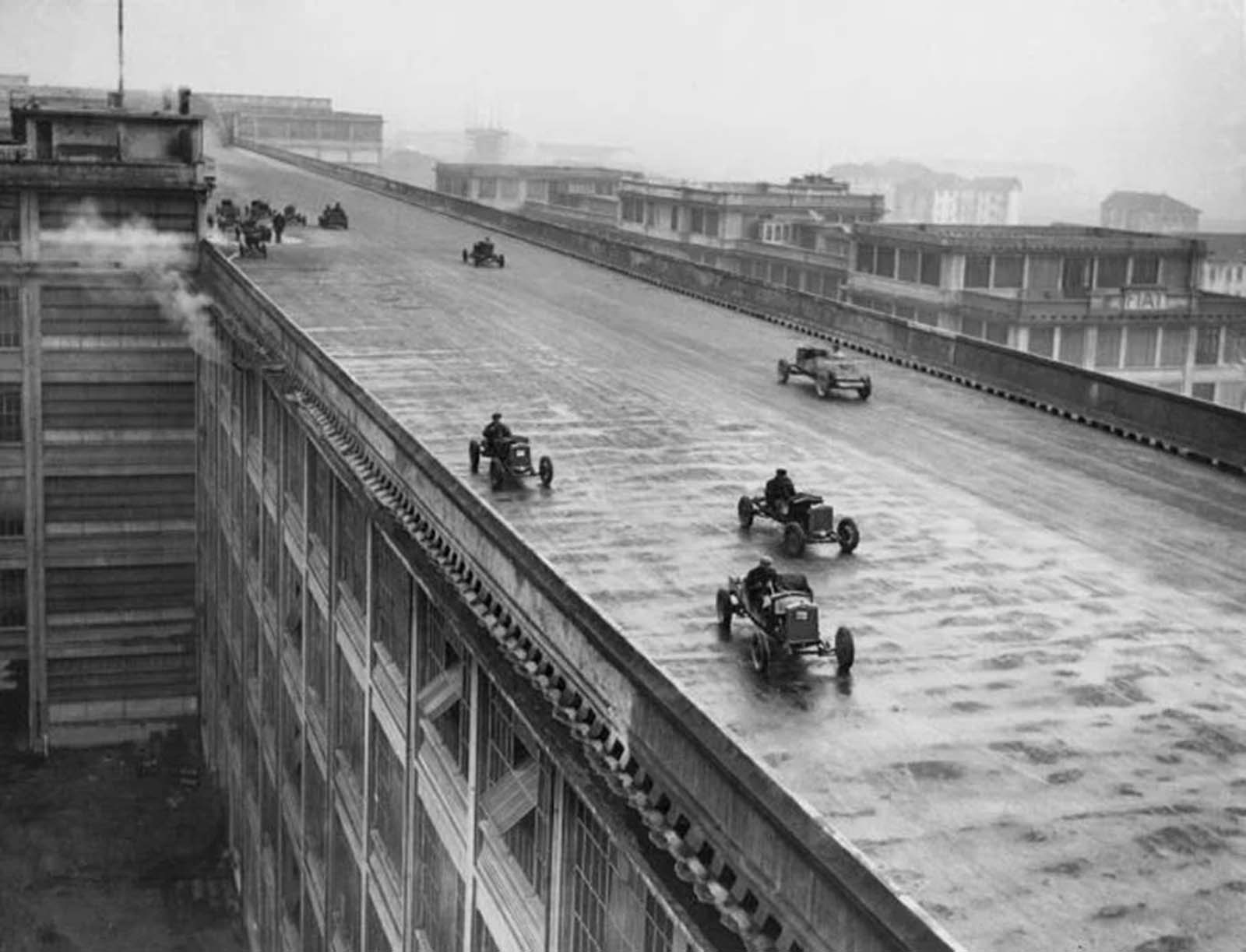
Finished cars emerged at the rooftop level to go onto the test track.
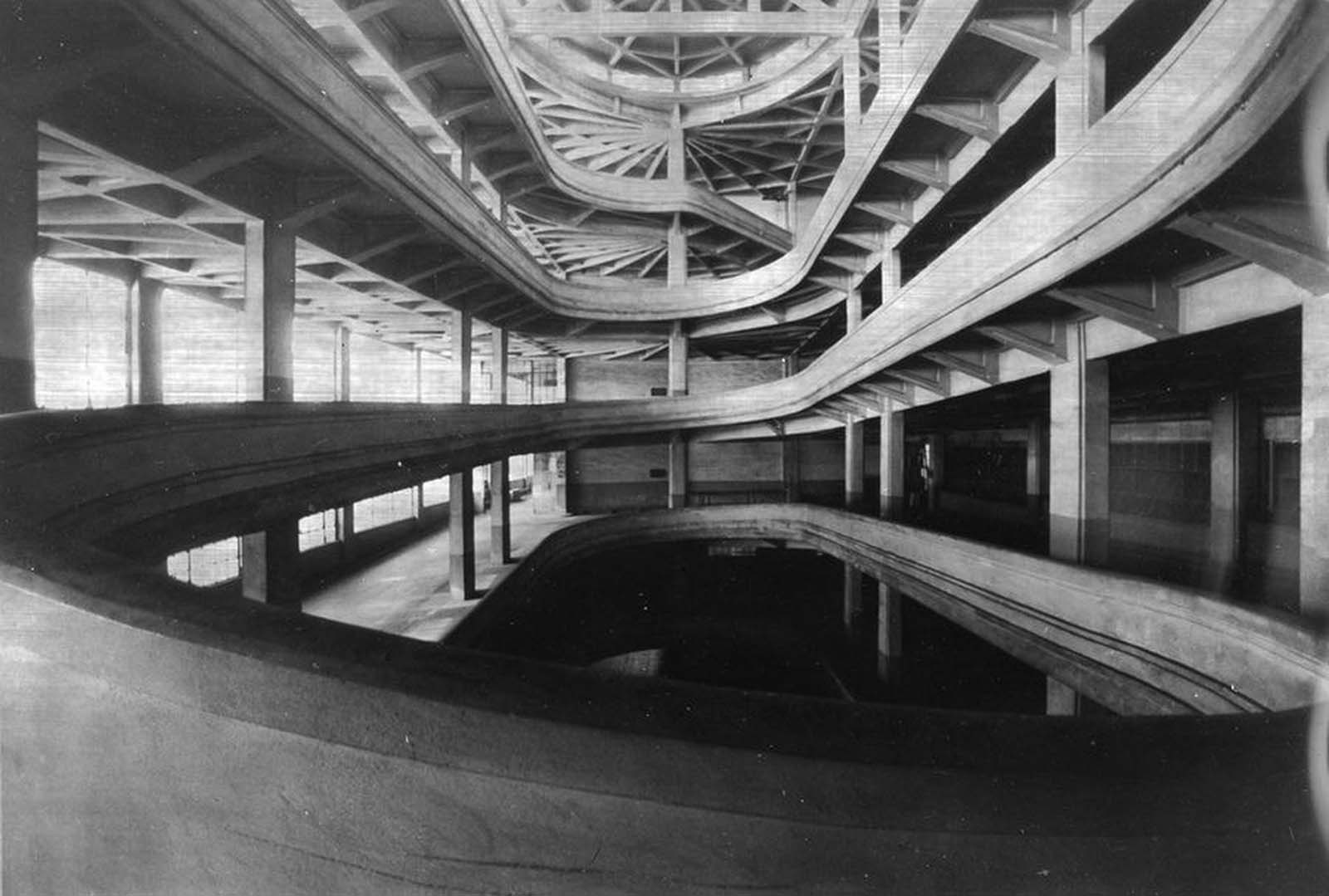
Interior to the Fiat Lingotto auto manufacturing plant.
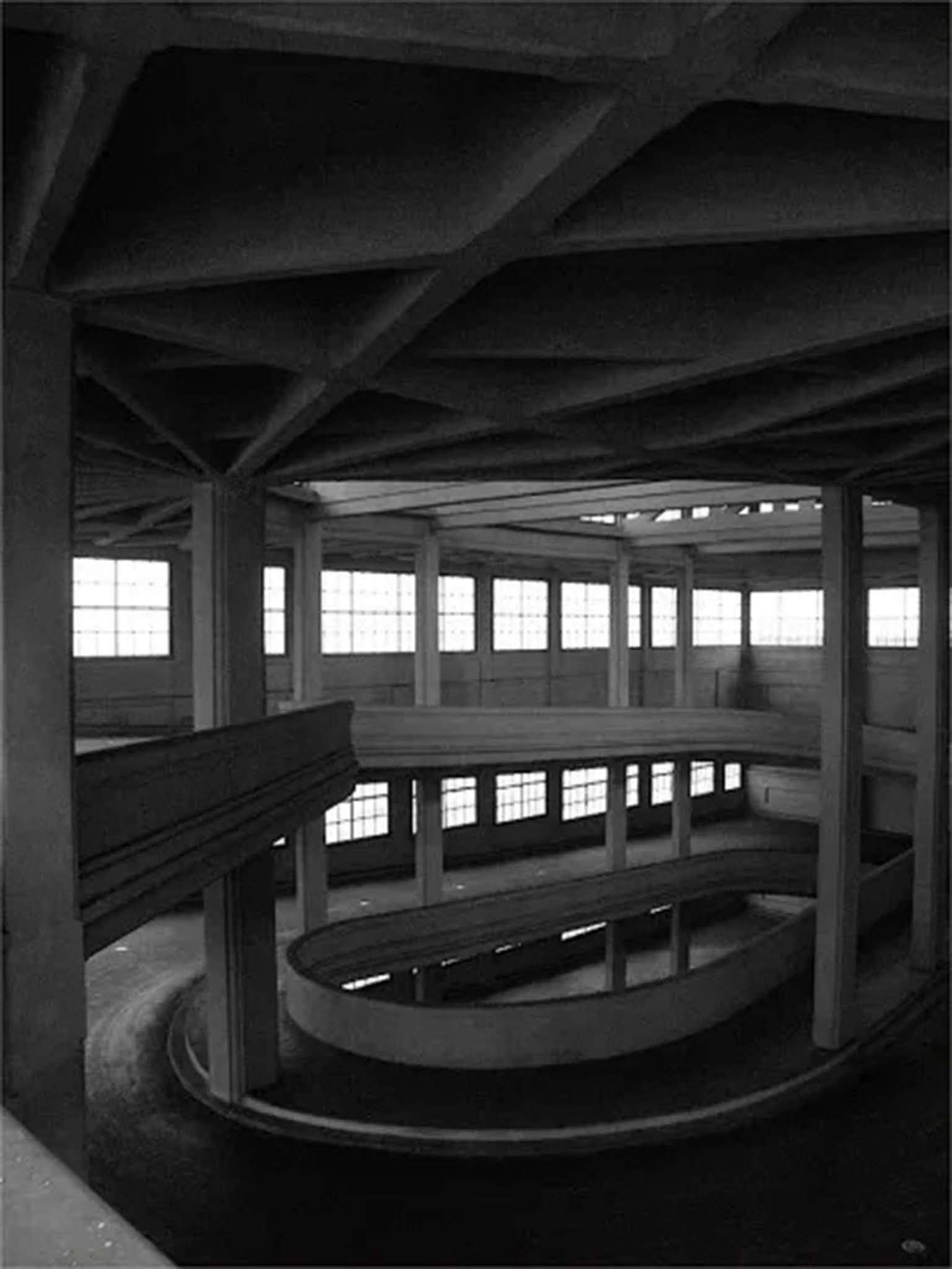
80 different models of car were produced there in its lifetime, including the Fiat Topolino of 1936.

The snail-shaped ramps.
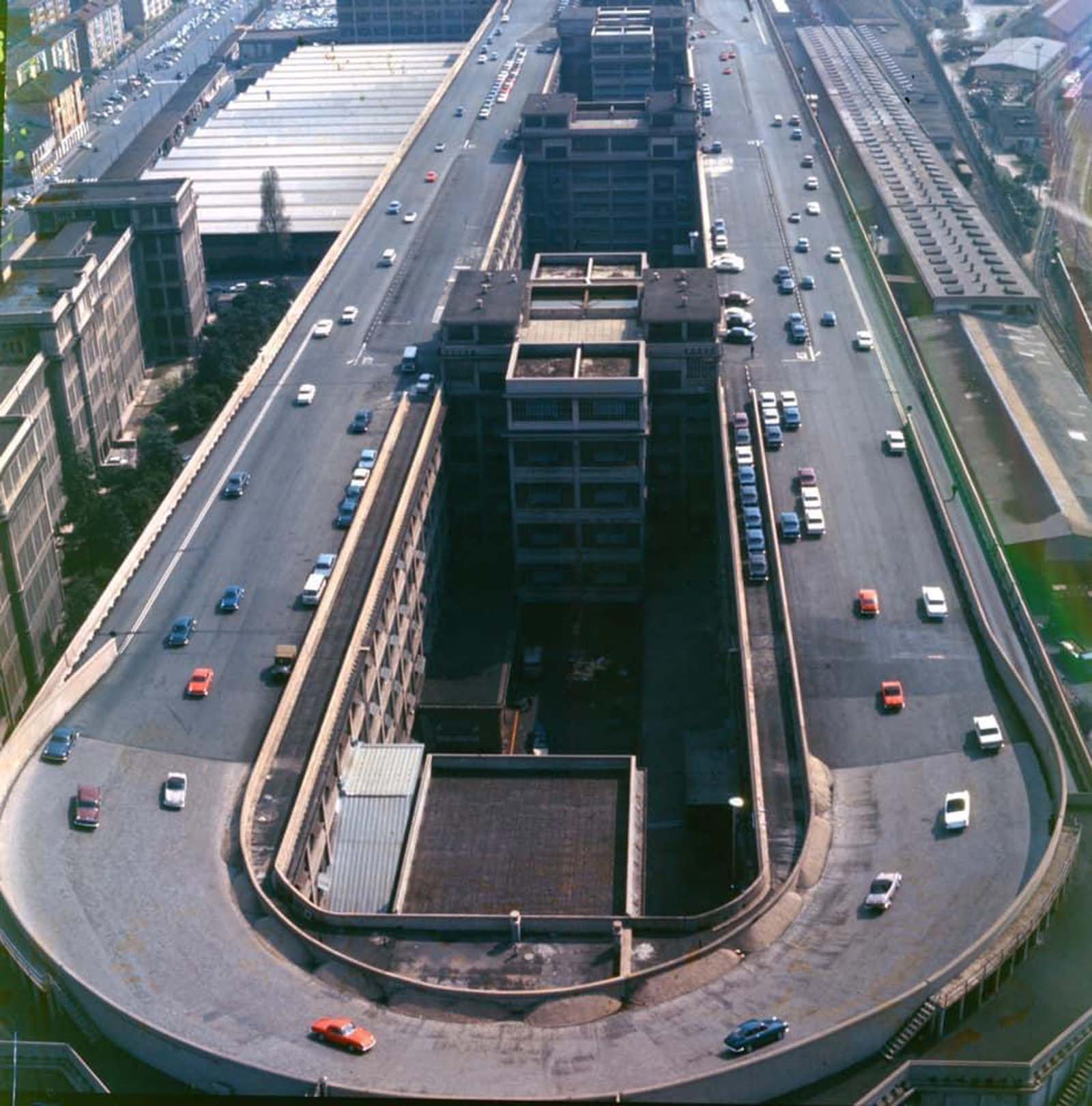
Another race taking place on the rooftop racetrack.
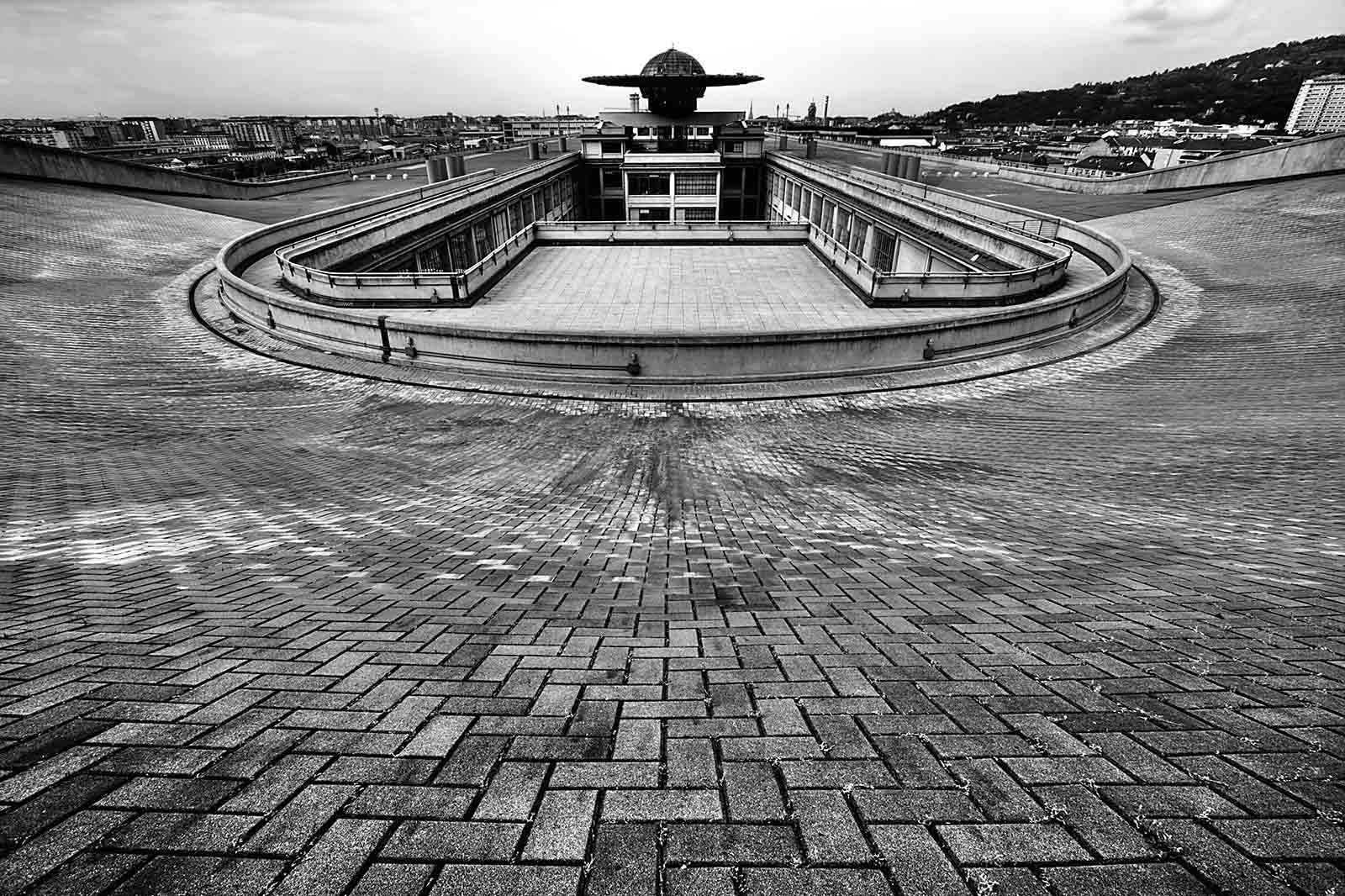
Another view of the racetrack.
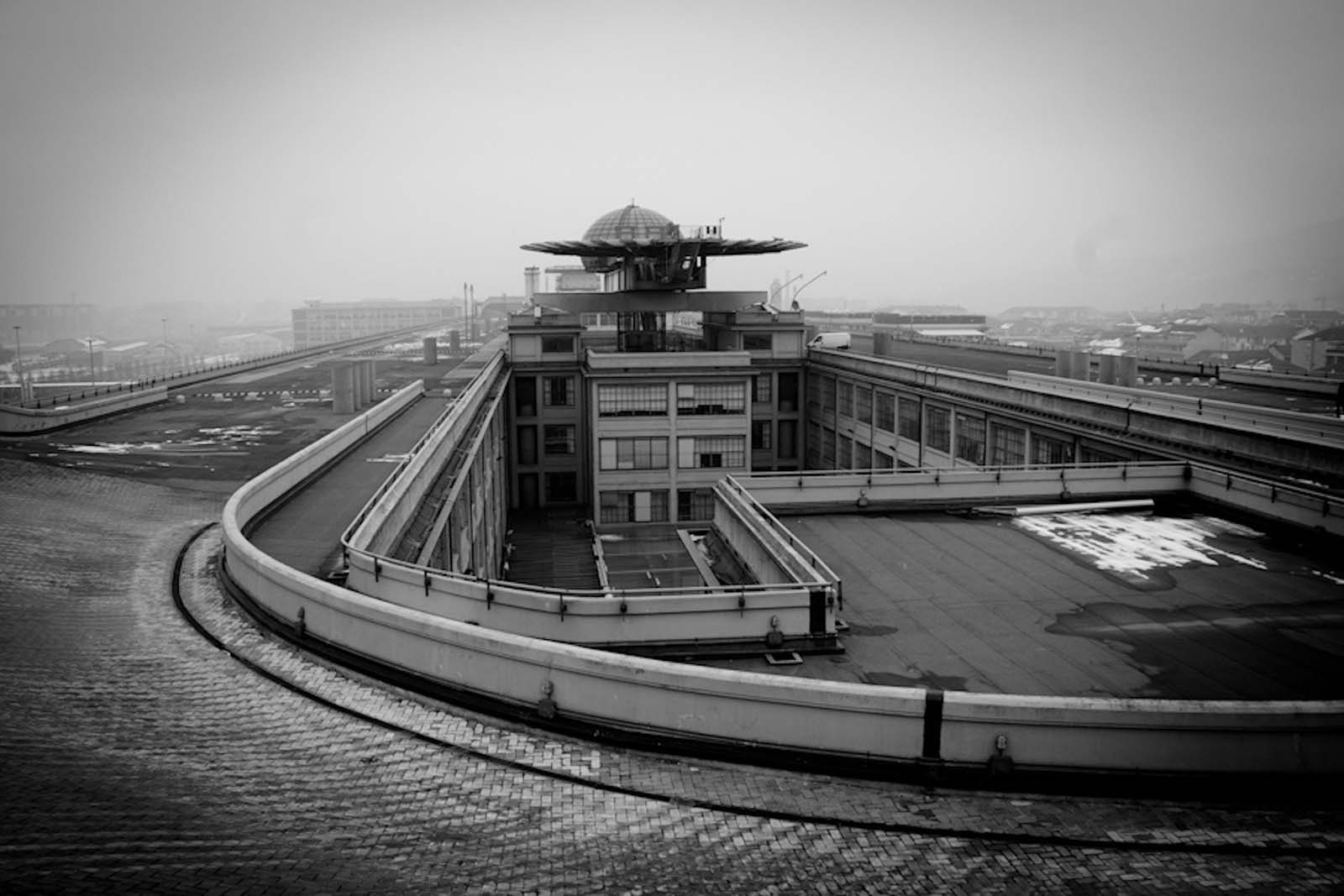
View from the rooftop racetrack.
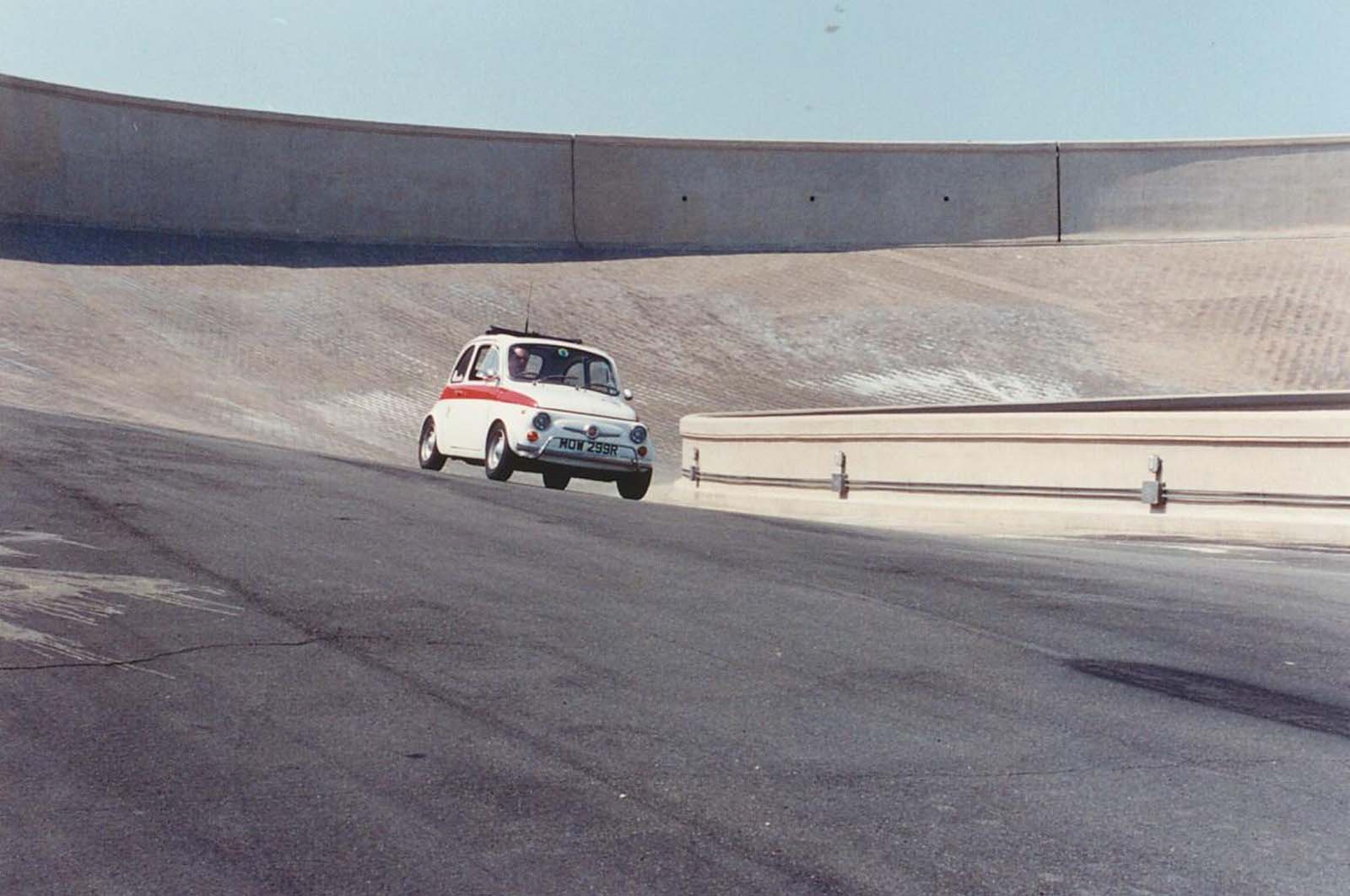
Taking a Fiat going for a test drive.
(Photo credit: Turin Guides / The Carnel House Organization / Getty Images).
Updated on: November 29, 2021
Any factual error or typo? Let us know.

Fiat Lingotto Factory
Lingotto is a district of Turin, Italy, and the location of the Lingotto building in Via Nizza. This building once housed an automobile factory built by Fiat. Construction started in 1916 and the building opened in 1923. The design by young architect Matte Trucco was unusual in that it had five floors, with raw materials going in at the ground floor, and cars built on a line that went up through the building. Finished cars emerged at rooftop level, where there was a rooftop test track. It was the largest car factory in the world at that time. For its time, the Lingotto building was avante-garde, influential and impressive. Le Corbusier called it "one of the most impressive sights in industry", and "a guideline for town planning". 80 different models of car were produced there in its lifetime, including the Fiat Topolino of 1936.
The factory became outmoded in the 1970s and the decision was made to finally close it in 1982. The closure of the plant led to much public debate about its future, and how to recover from industrial decline in general. An architectural competition was held, which was eventually awarded to Renzo Piano, who envisioned an exciting public space for the city. The old factory was rebuilt into a modern complex, with concert halls, theatre, a convention centre, shopping arcades and a hotel. The eastern portion of the building is the headquarter of the Automotive Engineering faculty of the Polytechnic University of Turin. The work was completed in 1989. The track was retained, and can still be visited today on the top floor of the shopping mall and hotel.
The only similar rooftop test track was in Nessonvaux, Trooz, Belgium. From 1928 to 1958, Imperia had a track over 1 km long which was built partially on top of the factory.
"...this vast, five-storey, reinforced concrete industrial loft is still in use. The five floors are ordered sequentially to provide for (1) maintenance and motor testing (2) engine machining and body assembly, (3) gear box and differential steering, (4) spraying, upholstering, suspension and differential steering, (5) lorry production and (6) testing. This last takes place in the open air, on the roof where a banked reinforced concrete racetrack has been provided, on an area measuring 1680 feet by 260 feet. At the ends the banking to this track rises some 15 feet in 55 feet and this activation of the roof, together with its highly sculptural form was to inspire Le Corbusier's conception of the roofscape for his Unite apartment block built at Marseilles in 1952."
"...this is a pioneering work in the application of reinforced concrete construction to an industrial plant. It was designed significantly enough by a naval engineer. Accommodating some 6,000 workers in 16,000,000 square foot of floor space, it was an undertaking of unprecedented size. From a structural point of view, however, the most remarkable innovation was the helicoidal car ramps at either end of the block which were braced by an extremely elegant system of reinforced concrete ribs, a system which in retrospect recalls the theoretical projects of de Baudot and seems to anticipate the later realizations of Pier Luigi Nervi, such as his Gatti Wool factory built at Rome in 1953."
- in Modern Architecture written by Kenneth Frampton and Yukio Futagawa
The Lingotto building is featured extensively in the Alberto Lattuada film Mafioso (1962). The original Lingotto rooftop test track features briefly in the getaway sequence in the film The Italian Job (1969). Lingotto is the site of the Oval Lingotto, the speed skating venue for the 2006 Winter Olympics. The building is also featured in the fourth episode of the 20th season of The Amazing Race, originally aired in the US on March 11, 2012.

- Wikipedia en.wikipedia.org
All our texts and many of our images appear under the Creative Commons Attribution Share-Alike License ( CC BY-SA ). All our content is written and edited by our community.

Teatro Continuo

Palace of Congresses and Receptions
Fiat’s iconic modernist factory hosts new urban oasis
Fiat’s former Lingotto factory and test track are transformed into Europe’s largest hanging garden – a new urban oasis for Turin
- Sign up to our newsletter Newsletter
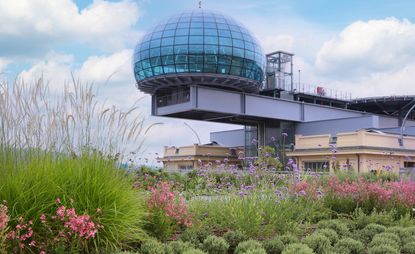
Turin is now host to Europe’s largest hanging garden , set high above the concrete modernist curves of the Fiat company’s Lingotto Factory. A collaboration between Turinese architect Benedetto Camerana and the botanist Cristiana Ruspa, La Pista 500 is a new public space and urban garden for Turin. It’s joined by Casa 500, a dedicated exhibition space within the Pinacoteca Agnelli, the Fiat family foundation housed in the Renzo Piano -designed structure built atop the Lingotto complex in 2003.
Casa 500 is dedicated to Fiat’s most celebrated model, the Fiat 500, both in its original 1957 incarnation and its hugely successful 20th century revival . Featuring original artwork, models and ephemera from the company’s collection, Casa 500 was designed by the Italian firm LAB71 Architetti, led by Massimiliano Gotti Porcinari.
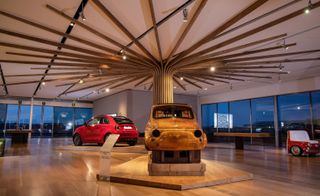
Casa 500, an exhibition space that celebrates of the Fiat 500, old and new
La Pista 500 is a linear park in the sky, enhancing the city’s biodiversity with 40,000 plants comprising of 300 species, housed in 28 island planters set within the factory’s original concrete test track. Giacomo Mattè Trucco (1869 –1934) originally conceived the Lingotto complex as a temple of manufacturing, a five-floor production line that eschewed the sprawling facilities of Fiat’s American counterparts in favour of a more vertical solution.
Components and raw materials went in on the ground floor and production snaked its way up towards the roof, complete with dramatic spiralling concrete ramps at each end of the 1.5 million sq m complex. On the summit was the company’s crowning glory, a test track with steep concrete banking. Over the next half century, some 80 models of Fiat were built here, including the original Topolino city car of the 1930s.

La Pista 500, a new urban garden for Turin, set alongside the 1920s test track and Renzo Piano's additions, including the Pinacoteca Agnelli (centre)
Piano and his team spent 20 years working on the renovation of the structure after the factory closed in 1982, transforming the former production lines into offices, two hotels, a conference centre, and retail space.
The transparent ‘bubble’ structure on the roof is the most obviously high-tech addition to the study of concrete modernism, counterbalanced by the exhibition space at the opposite end of the long, slender structure.
Urban oasis for Turin
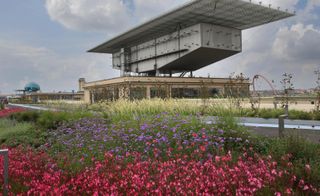
The new planting is juxtaposed with Renzo Piano's high-tech additions from the turn of the century
The La Pista 500 celebrates this enduring structure, saved from industrial oblivion by Piano’s interventions. The 7,000 sq m of new planting runs the 1.2km length of the test track, which has been given a new lease of life as a place to drive electric only vehicles , including bikes and scooters.
Wallpaper* Newsletter
Receive our daily digest of inspiration, escapism and design stories from around the world direct to your inbox.
The new vegetation has been designed to maximise biodiversity, avoiding the need for excessive water consumption, and there’s an education space, a kitchen garden, and even zones dedicated to contemplation and meditation. Stellantis, Fiat’s parent company, acknowledges that the transformation of a concrete factory into a verdant public space is a ‘deeply symbolic’ act, and hopes it’ll be seen as a physical representation of its ongoing sustainable ambitions.

Archive image
INFORMATION
Pinacoteca Agnelli
Jonathan Bell has written for Wallpaper* magazine since 1999, covering everything from architecture and transport design to books, tech and graphic design. He is now the magazine’s Transport and Technology Editor. Jonathan has written and edited 15 books, including Concept Car Design, 21st Century House, and The New Modern House. He is also the host of Wallpaper’s first podcast.

Surrealism, restraint and a beautiful show of Blunk marked the new season of design events in the French capital
By Dan Thawley Published 14 September 24
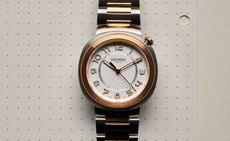
The Hermès Cut epitomises the clean design codes of the house
By Hannah Silver Published 14 September 24

A new Edinburgh exhibition addresses the issue of ash dieback with an inventive and optimistic response from Scotland’s design community
By Alyn Griffiths Published 14 September 24
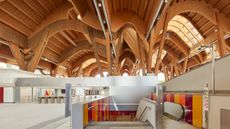
Naples Underground Central Station by Benedetta Tagliabue is a work of art that’s inviting and vibrant, matching its dynamic context
By Ellie Stathaki Published 14 September 24

‘Carlo Scarpa: The Complete Buildings’ is the perfect book for architecture enthusiasts
By Jonathan Bell Published 29 May 24
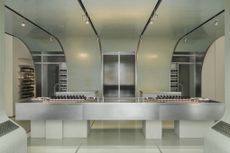
The latest Aesop Milan store to open is a hub of wellness, beauty and tranquillity in the Italian metropolis
By Ellie Stathaki Published 21 May 24
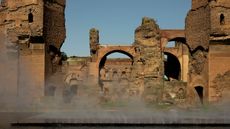
Architect Hannes Peer reveals a water mirror in Rome – an immersive architectural installation at the heart of the ancient Baths of Caracalla
By Ellie Stathaki Published 9 May 24

A private residence by Holly Waterfield Interior Design in Renzo Piano's skyscraper 565 Broome Soho blends a sense of calm and cosiness with stunning city views
By Léa Teuscher Published 6 May 24

From small domestic gardens, to nature reserves, urban interventions and local parks, here are some of the finest green projects that place nature at their heart
By Ellie Stathaki Published 27 March 24

Giovanni Michelucci’s concrete Church of Santa Maria Immacolata in the Italian Dolomites is a reverently uplifting memorial to the victims of a local disaster
By Jonathan Glancey Published 16 March 24

Milanese concept store 10 Corso Como unveils its new look by 2050+, a stripped-back design that nods to its 20th-century character
By Ellie Stathaki Published 28 February 24
- Contact Future's experts
- Terms and conditions
- Privacy policy
- Cookies policy
- Advertise with us
Wallpaper* is part of Future plc, an international media group and leading digital publisher. Visit our corporate site . © Future Publishing Limited Quay House, The Ambury, Bath BA1 1UA. All rights reserved. England and Wales company registration number 2008885.

IMAGES
VIDEO
COMMENTS
The Lingotto factory was opened in 1926 in the presence of King Vittorio Emanuele III. At that time, production had already started and the office building was complete. Back then, Lingotto was Europe's most advanced factory with about 12,000 blue collar workers and 500 white collar workers working three shifts in a continuous cycle.
You'll visit the original Lingotto test track rooftop that briefly features in the getaway sequence of "The Italian Job" movie and you will enjoy a breathtaking view of the city from the Lingotto's roof garden. The visit will continue inside Eataly, that once was the first factory of Carpano Vermouth and where today stands the Museum. You ...
The Lingotto factory was the first example of modular construction using reinforced concrete and it is constructed in the form of two parallel buildings, each 507 meters (1662 ft) in length, 5 stories high and each arm is joined in three places by 5 story high office linkways. At each end of the building there was a spiral ramp linking each floor.
Discover Fiat Lingotto Factory in Turin, Italy: Now an entertainment complex, the Lingotto building was once an avant-garde auto factory with a test track on the roof. ... Visit Adventures.
The Lingotto building has since been renovated and turned into a commercial complex with hotels and a shopping mall, and you can visit it and see its most unique feature - a race track on the roof!
Lingotto. Coordinates: 45°1′57″N 7°39′52″E. Historical view of Lingotto building with the test track on the roof (1928) Lingotto is a building complex on Via Nizza in Turin, Italy. It once housed a car factory built by Italian automotive company Fiat and today houses the administrative headquarters of the manufacturer and a ...
Work on the test track, perhaps the most famous symbol of the factory, was completed in 1921. The North and South Ramps, the other two symbols of the Lingotto, were completed in 1925 and 1926, when the office building, home to the company's Board of Directors, was also inaugurated.
The Fiat Lingotto Factory in Turin, built in the 1920s, was the largest and most modern car factory in Europe. ... Today, you can take a lift from the centre up to the roof and see the iconic track for yourself - something any visitor to Piedmont should make time to do! Photo credits picture 1: TuRbO_J / CC BY 2.0;
Lingotto. Turin's former Fiat factory, one of Italy's most praised examples of early-20th-century industrial architecture, is 5km south of the city centre. It was redesigned by architect Renzo Piano in the 1980s to house an exhibition centre, a university campus and hotels. The starkly beautiful space today houses the 8 Gallery shopping mall ...
You'll visit the original Lingotto test track rooftop that briefly features in the getaway sequence of "The Italian Job" movie and you will enjoy a breathtaking view of the city from the Lingotto's roof garden. The visit will continue inside Eataly, that once was the first factory of Carpano Vermouth and where today stands the Museum.
We will enjoy a breathtaking panorama of the city and a view of the brand new garden carved out of the Lingotto's roof, considered the largest roof garden in Europe. We will continue our visit at Eataly, where the first Carpano Vermouth factory once stood and where today you can visit the curious Vermouth Museum.
In 1923, the Lingotto Factory opened its doors as the largest car factory in the world. The immense 16,000,000 square foot space employed over 12,000 workers and cultivated over 80 different models of Fiat automobiles, including the 1936 Fiat Topolino, putting Italy at the forefront of the automotive industry.
The huge new factory designed by Giacomo Mattè-Trucco dominated the Lingotto district of Turin. 500m long, five storeys high and with a test track on the roof (immortalized in the film The Italian Job). Fiat is an acronym for Fabbrica Italiana di Automobili Torino but it's also a Latin expression, 'Let it be done.'.
The tour continues with a coach ride from where you can admire the first FIAT factory, the Olympic Stadium and the annexed architectural works, up to the Automobile Museum, that you will visit inside. Available: from Wednesday to Sunday at 10am. Not available on December 24, 25 and 31st, and on January 1st. Duration: 5 hours
Visitors on the Torino Fiat Lingotto District tour will have the opportunity to explore a collection of over 150 cars spanning from the oldest to the most recent models, all while enjoying a glass of sparkling wine. The tour not only offers a wine tasting experience but also delves into the rich automotive history of Fiat.
The last Lancia Delta rolled out of the factory in 1979. Three years later, the factory was officially closed. The Lingotto building was eventually converted into a modern complex with concert halls, theatre, a convention center, shopping arcades and a hotel. The rooftop track was retained and can still be visited today on the top floor.
The Lingotto factory was completed in 1923 as the world's largest automotive plant at the time. Fiat built a total of 80 models in Lingotto before it was closed in 1982. The rooftop - 28 ...
The Lingotto factory was opened in 1926 in the presence of King Vittorio Emanuele III. At that time, production had already started and the office building was complete. Back in the day, Lingotto was Europe's most advanced factory with about 12,000 blue-collar workers and 500 white-collar workers working three shifts in a continuous cycle.
Designed by architect Giacomo Matté-Trucco, the Lingotto factory originally opened in 1923. The gorgeous modernist building measures 500 m (1,640 ft) in length and reaches a height of 28 m (91 ft).
Giacomo Matte-Trucco. Lingotto is a district of Turin, Italy, and the location of the Lingotto building in Via Nizza. This building once housed an automobile factory built by Fiat. Construction started in 1916 and the building opened in 1923. The design by young architect Matte Trucco was unusual in that it had five floors, with raw materials ...
Benedetto Camerana adds garden with 40,000 plants to the rooftop test track at Fiat's former Lingotto factory. Italian architect Benedetto Camerana and landscape designer Il Giardino Segreto have ...
last updated 9 October 2022. in News. Turin is now host to Europe's largest hanging garden, set high above the concrete modernist curves of the Fiat company's Lingotto Factory. A collaboration between Turinese architect Benedetto Camerana and the botanist Cristiana Ruspa, La Pista 500 is a new public space and urban garden for Turin.